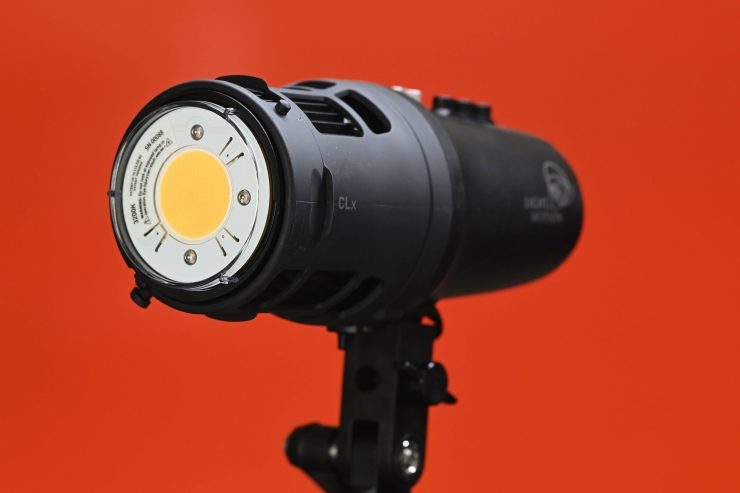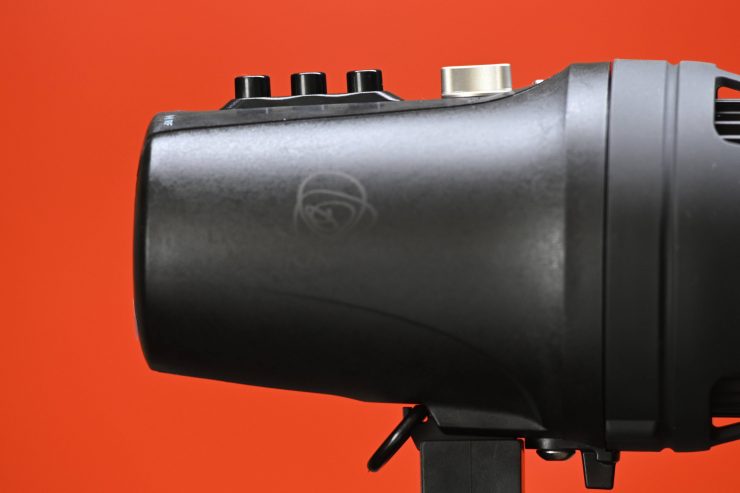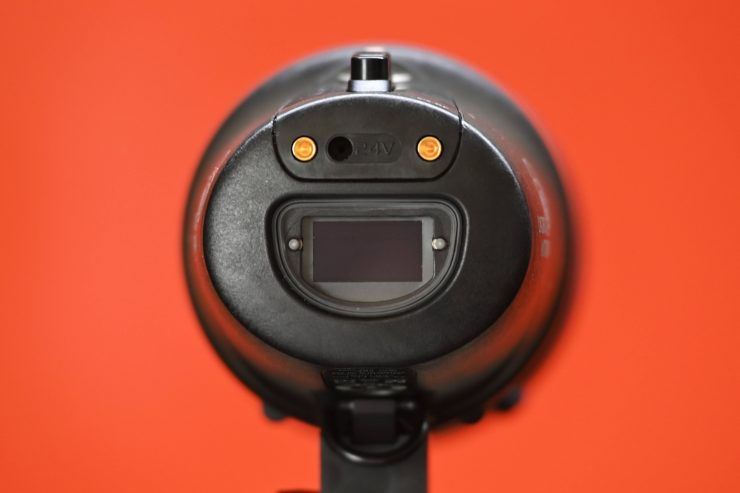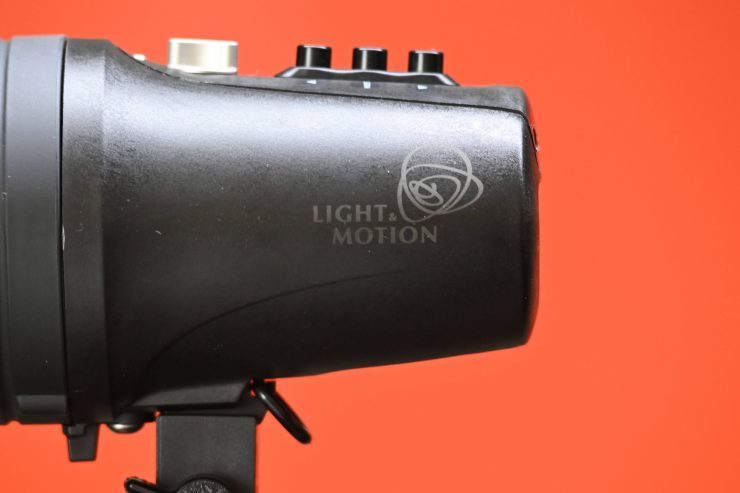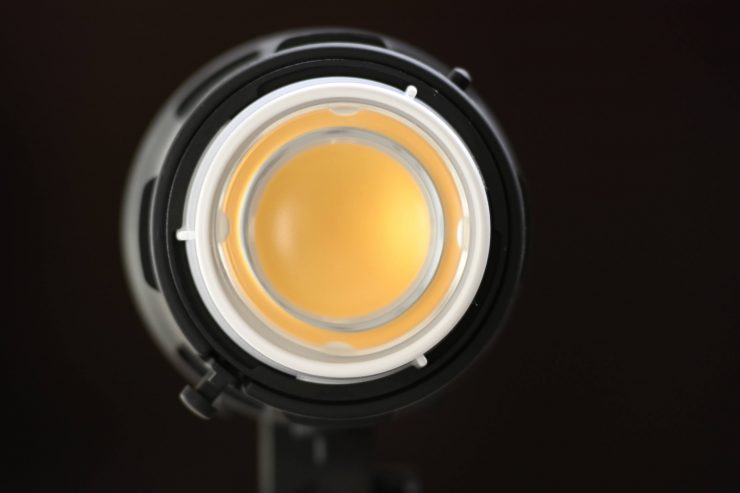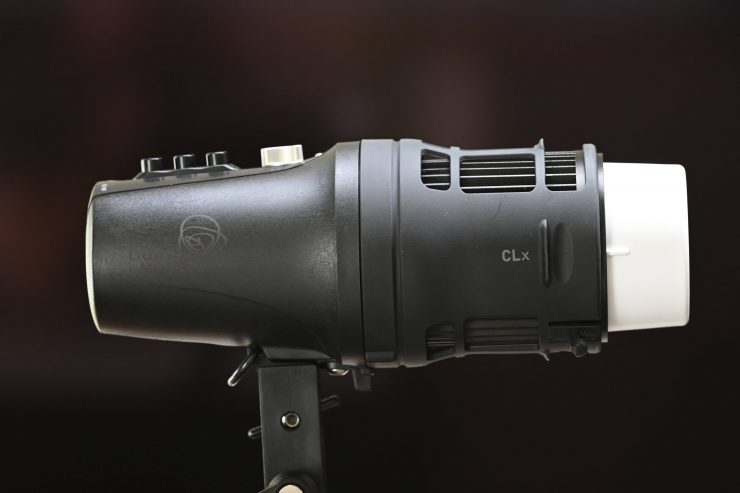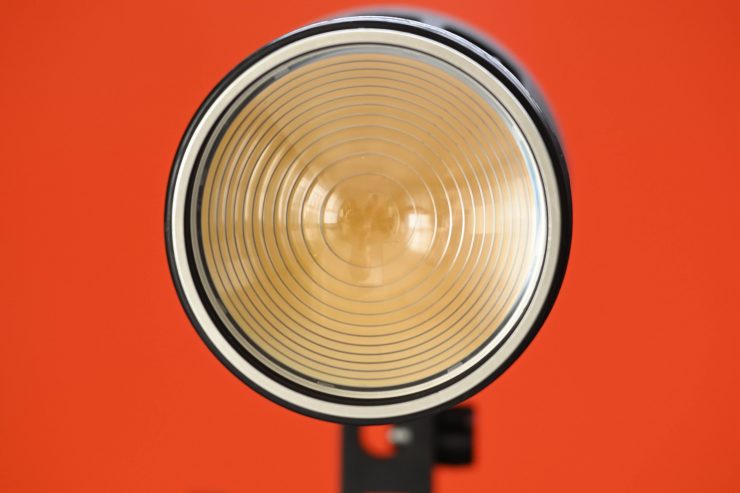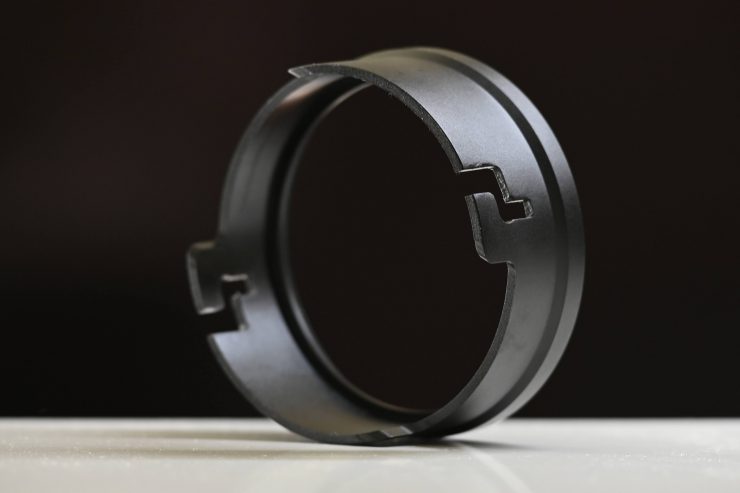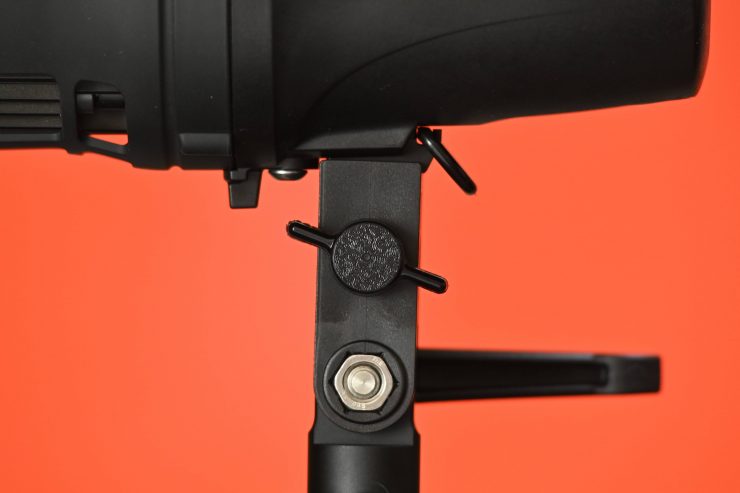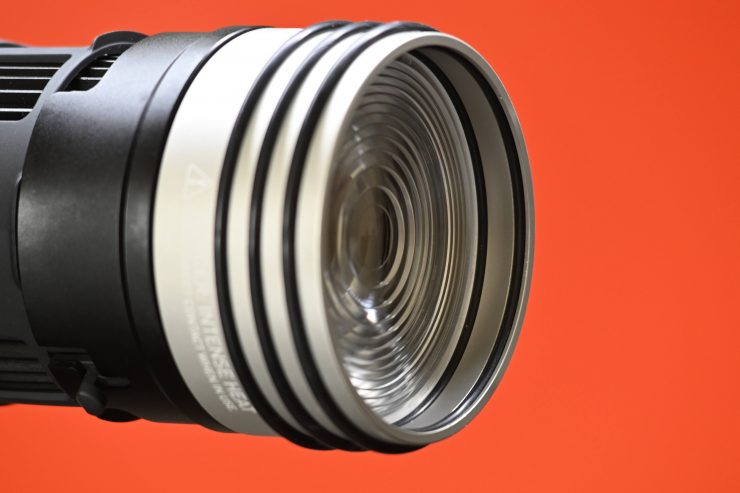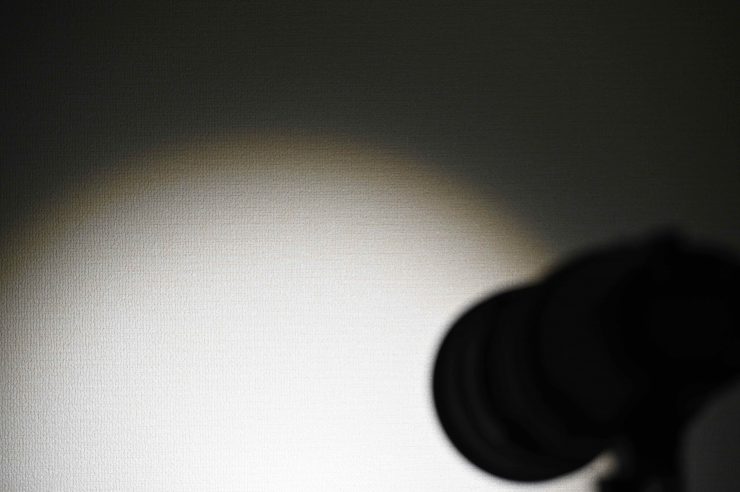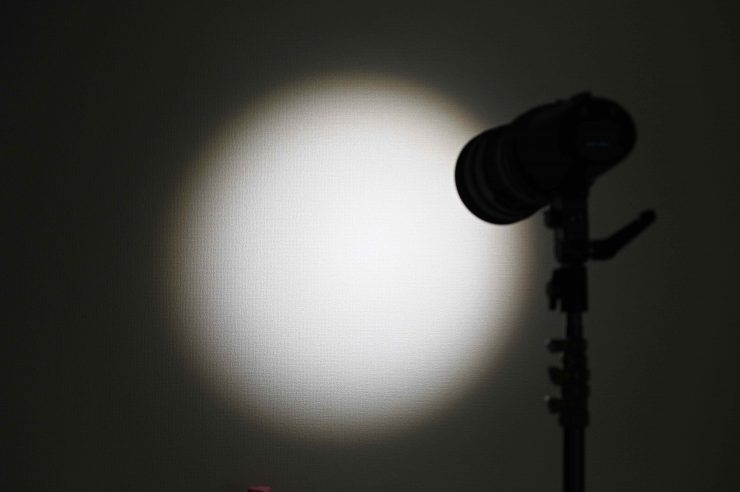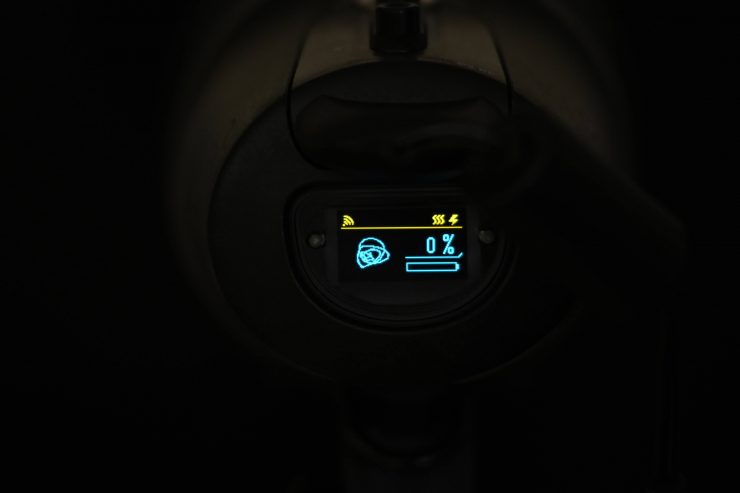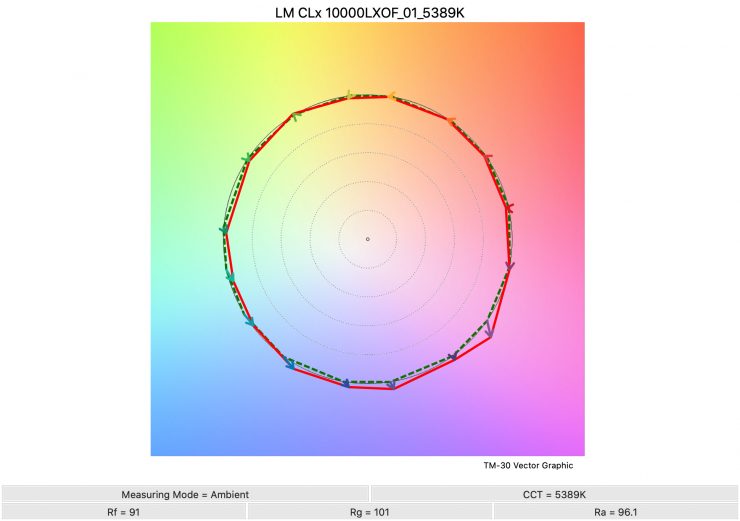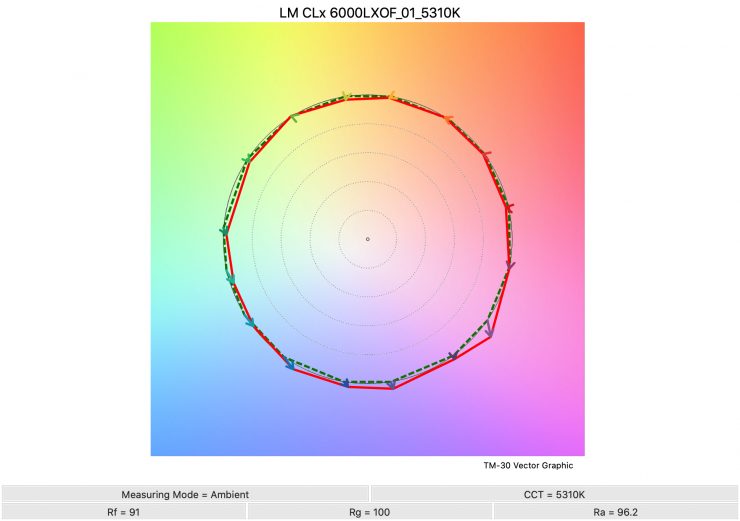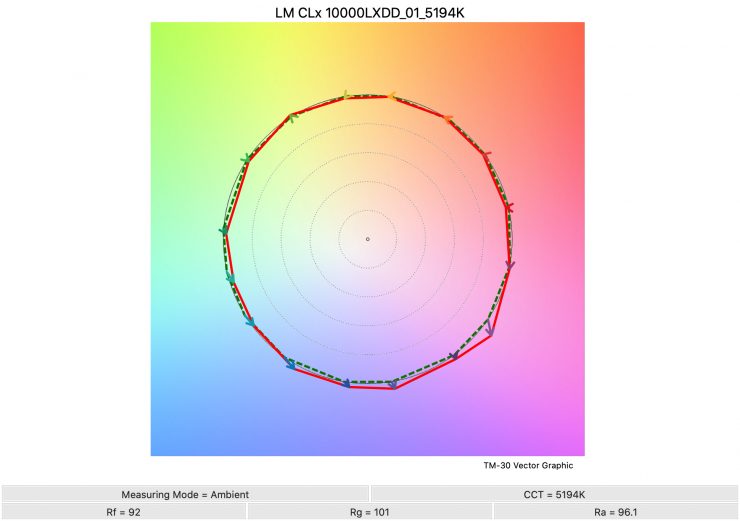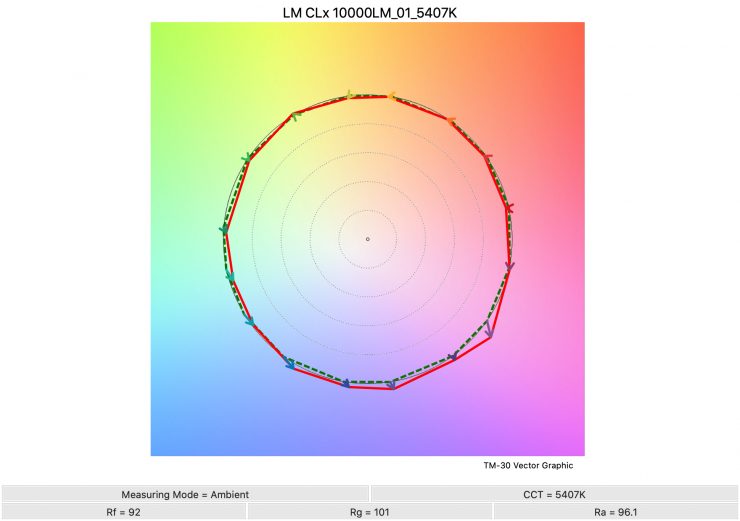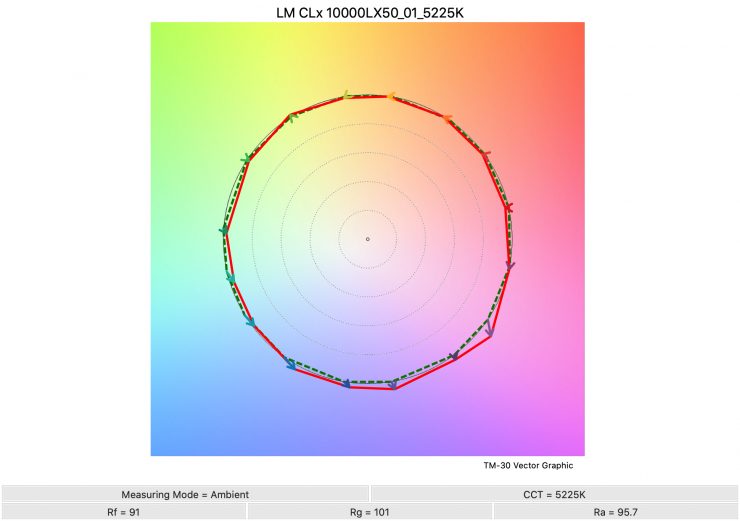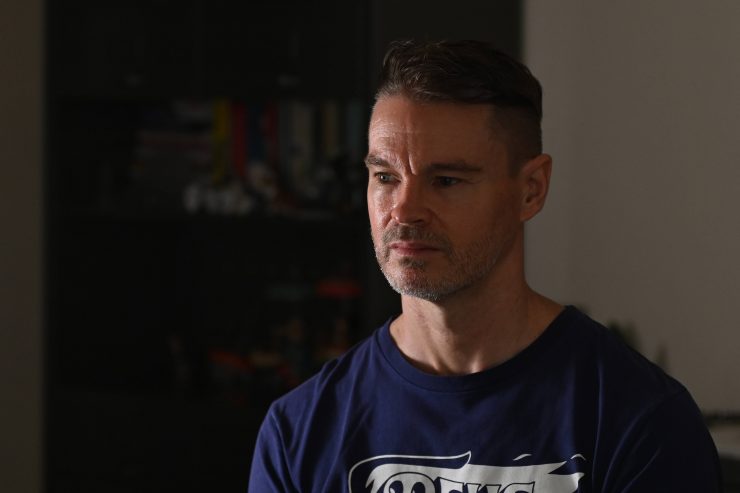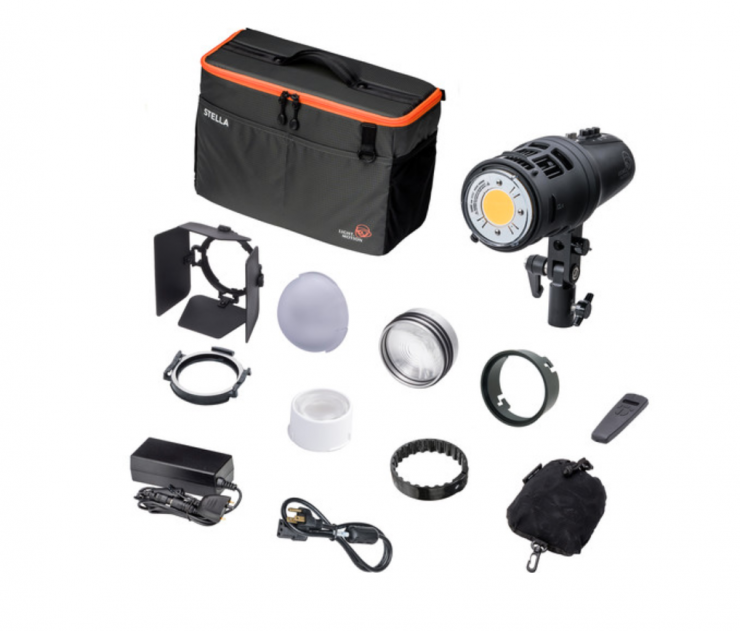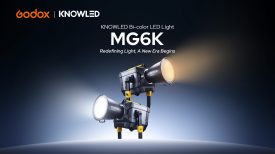
The Light & Motion CLx10 is a small-sized, high output LED light that can be used for both video and photo applications.
In a lot of ways, the Light & Motion CLx10 is quite a niche light, especially for video shooters. However, because of its size and versatility, it is certainly a light that is worth looking at.
Light & Motion has been making small-sized, high output LED lights since 1989. The breakthrough moment that put them on the map was arguably when they released the CL series in 2015. The subsequent Stella and Sola lights helped cement the companies reputation in the industry.
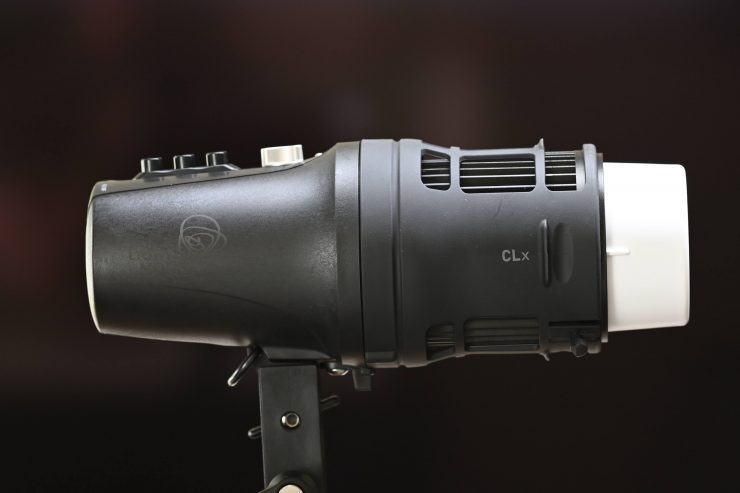
This small-sized LED might be a good solution for traveling shooters and single person operators who want a light that is compact, versatile, and doesn’t take up much space in a bag. What you do clearly need to keep in mind is that this is a fixed 5600K Kelvin color temperature light. It is also a hard light source that you will need to diffuse for certain applications.
The beam angle is 120°. That 120° beam angle can be modified with optional 25 and 50° lenses. The light can also take advantage of direct-mount and press-on light-shaping tools that are compatible with leading light modifiers from Elinchrom, Profoto, Bowens, and Westcott. The ability of this light to be used with a wide array of lighting modifiers helps with its versatility.
COB
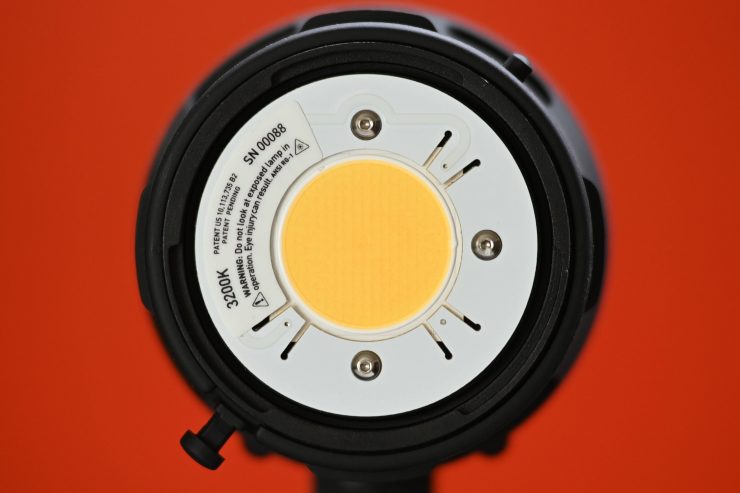
Quite a few LED lights on the market, including the Light & Motion CLx10, are using COB technology. COB stands for “Chip On Board” where multiple LED chips are packaged together as one lighting module. The advantage of COB LEDs being multi-chip packaged is that the light-emitting area of a COB LED can contain many times more light sources in the same area that standard LEDs could occupy. This results in a greatly increased lumen output per square inch.
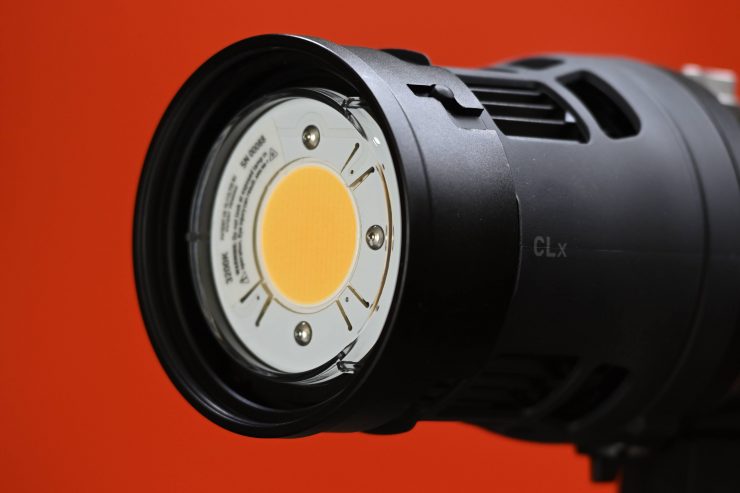
The downside to COB is that they generate an awful lot of heat. The CLx does indeed generate a lot of heat and you need to be mindful of this. The front of the light gets very hot and if you use the fresnel attachment there is actually a warning on the front that states- Danger: Intense Heat. Avoid contact when in use.
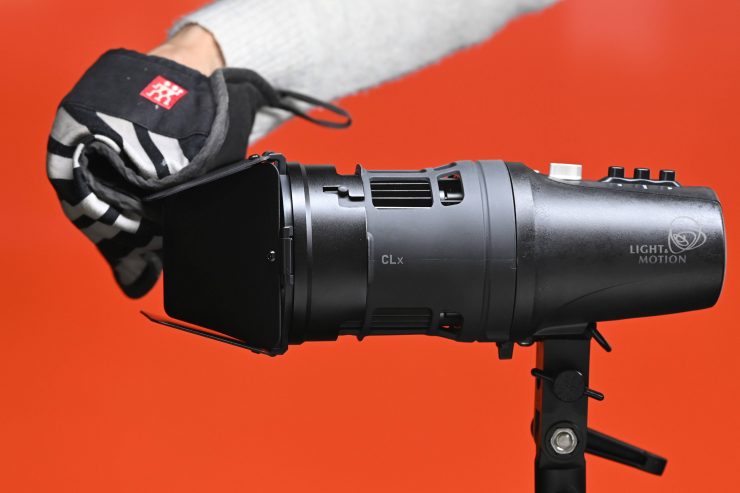
One of my biggest complaints with this light is that it gets so hot that I found myself having to use an oven mitt to take any accessories off.
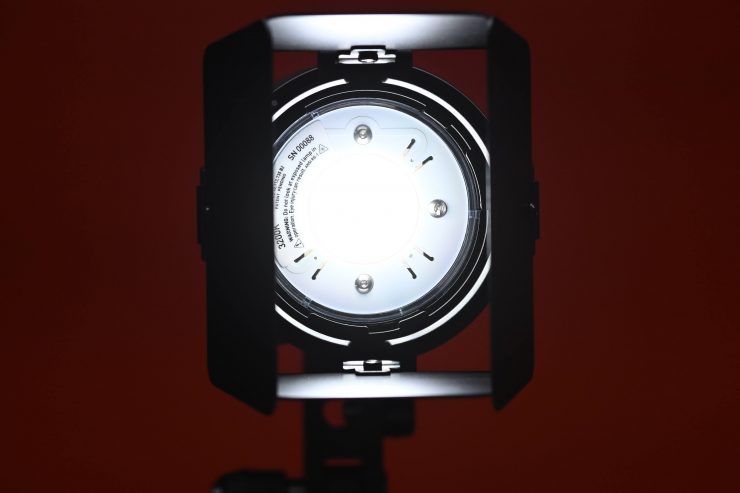
The other problem with COB LED lights is that unless you diffuse them they are very bright to look at and unsuitable for directly lighting talent. They are also extremely dangerous for your eyes. You should never use a COB LED light without diffusion if anyone is looking at it. I can’t stress this enough.
What do you get?
- Light & Motion CLx10 LED Light
- Light & Motion Profoto Adapter for Stella Pro 5000/5000 RF and Pro 8000
- Light & Motion YS Mount Base with Umbrella Holder for Stella 1000/2000 Lights
- Light & Motion Flat Port DM for Stella CLx
- Light & Motion C-Stand Mount for Stella LED Lights
- Light & Motion High Leverage Handle for Stella YS Mount
- Light & Motion Power Adapter for Stella Pro 5000 & Sola 8000 (24V, US/JP)
- Limited 2-Year Warranty on Light
- Limited 90-Day Warranty on Battery
Size & Weight
The Light & Motion CLx10 tips the scales at 2.7 lb (1.22 kg) and it has physical dimensions of 3.8 x 3.8 x 8.0″ / 9.7 x 9.7 x 20.3 cm.
Build quality
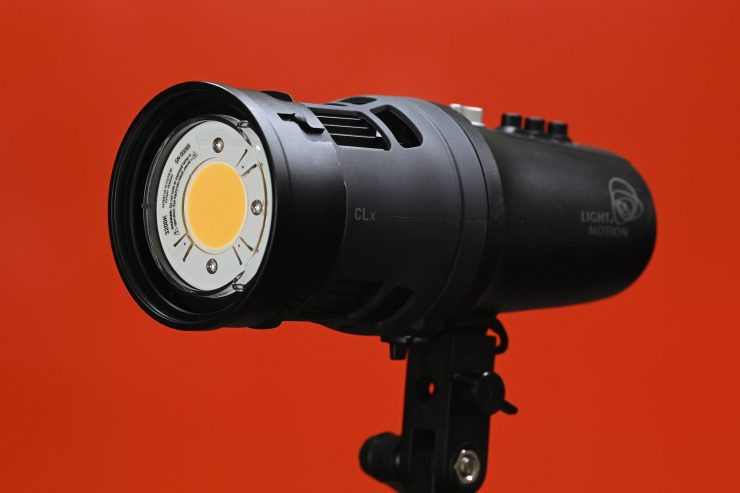
The light feels fairly solid in the hand and the overall build quality is good. The buttons and dials on the top of the light are ok, but they are not that tactile.
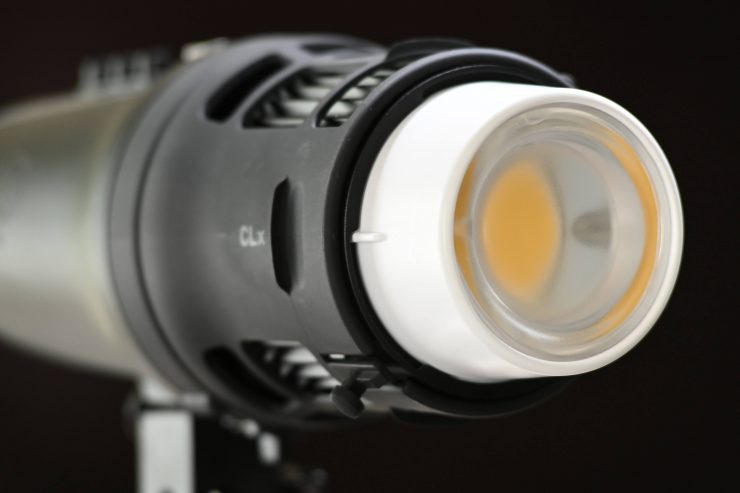
The front of the light uses a push in and 1/8 turn mount for attaching direct mount modifiers such as the Dome Diffusion and the 50-degree focus optic.
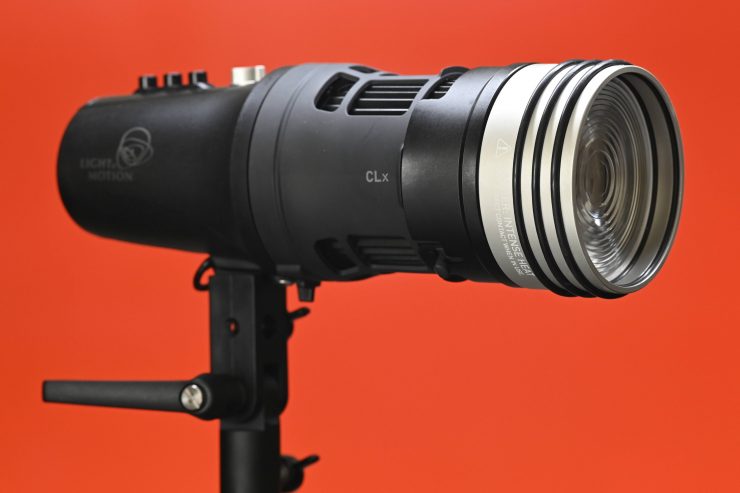
To put other items such as the 25-degree Fresnel, you first need to install the press on modifier interface.
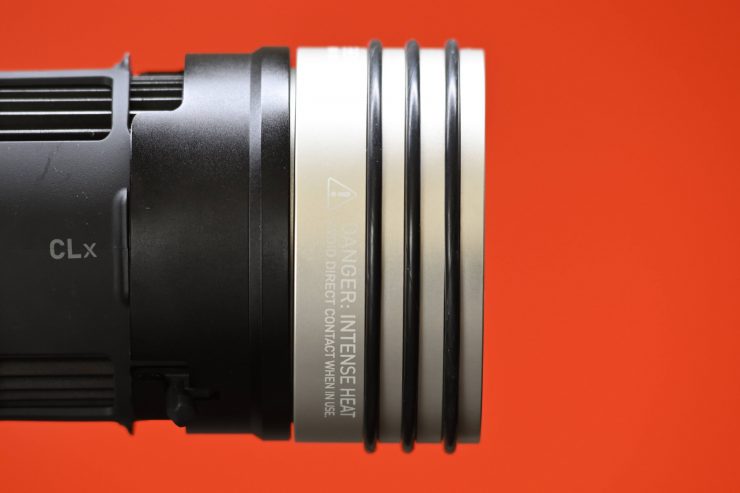
The only problem with this type of press on mount is that the Fresnel wobbles around because it isn’t physically being threaded or screwed onto anything. This is fine if you are indoors, but if you are using the light outdoors and it is windy, the Fresnel may move around and make unwanted noise. The light could also physically move which could also effect what you are doing.
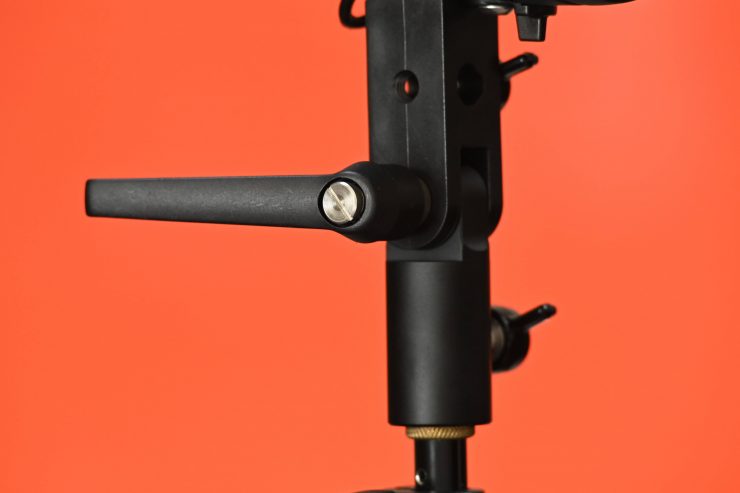
The light does have a removable mount but you need to use an Allen key to take it off. Everything locks down securely and the included mount offers a lot of flexibility to attach items such as umbrellas.
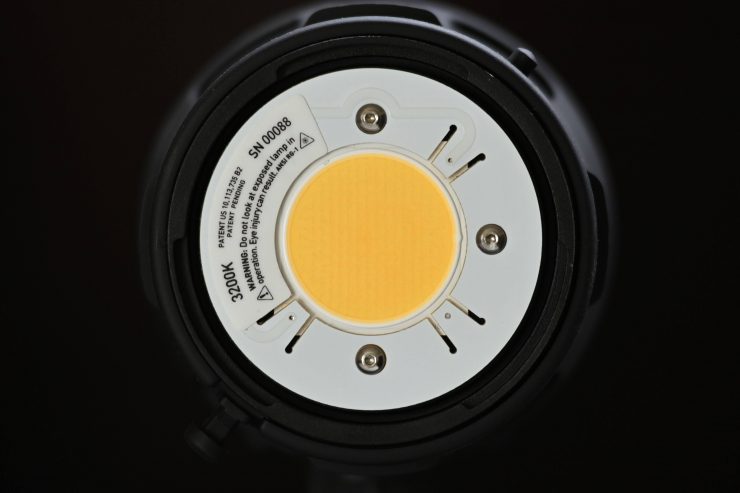
The light that was sent out for testing was mislabeled on the front COB element. There is a sticker saying 3200K, when in fact this is a 5600K fixture. This may be a small thing, but when you are paying a lot of money for a light, the small details matter. This is something I would expect to find on a $150 Amazon light, not on a fixture that costs more than $1,000 USD.
The light does come with a 2-year warranty.
Weather Resistant
The CLx10 is IP54 rating, making it weatherproof and resistant to impact damage from a height of 3.28′. An IP54 rating also means it has protection against splashing water from any direction, tested for a minimum of 10 minutes with an oscillating spray (limited ingress permitted with no harmful effects).
Having a light that can be used out in the elements is very useful, especially for documentary and news work.
Does the Fresnel attachment have color fringing or multi-shadows?
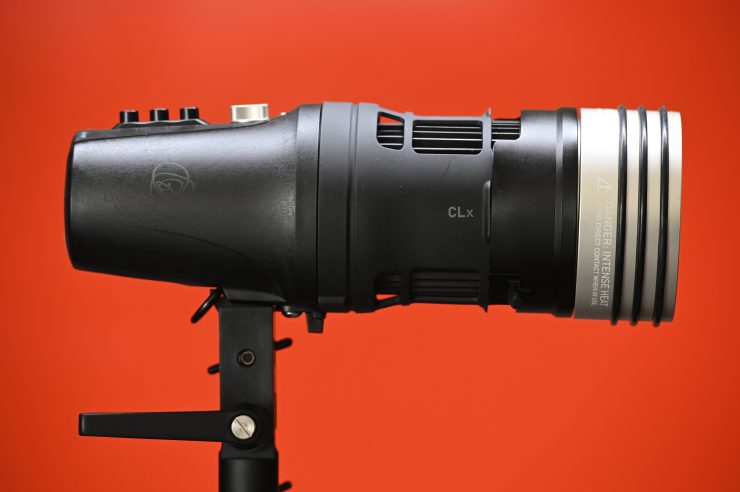
According to Light & Motion, the CLx10 positions the light source directly behind the modifying optics. This is done to help eliminate optical inefficiencies or multi-shadow effects.
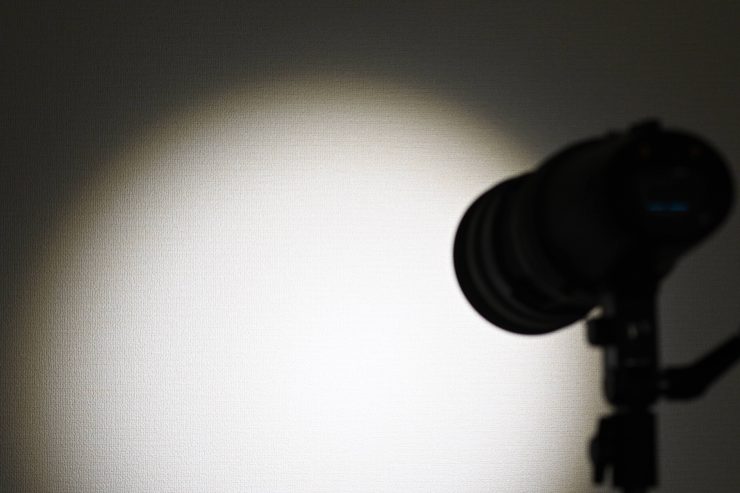
I tested out the color fringing when using the Fresnel lens attachment, and it definitely does exhibit signs of color fringing. It is a little hard to see in the photos above, but there is a very visible yellow fringe occurring.
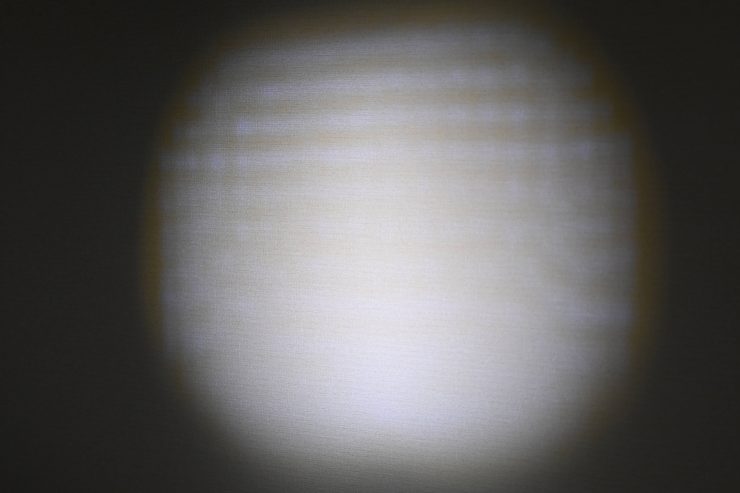
Above you can see how horrible it looked when using the Fresnel attachment and the barn doors. Please bear in mind that the light was placed around 3′ from the wall for this example.
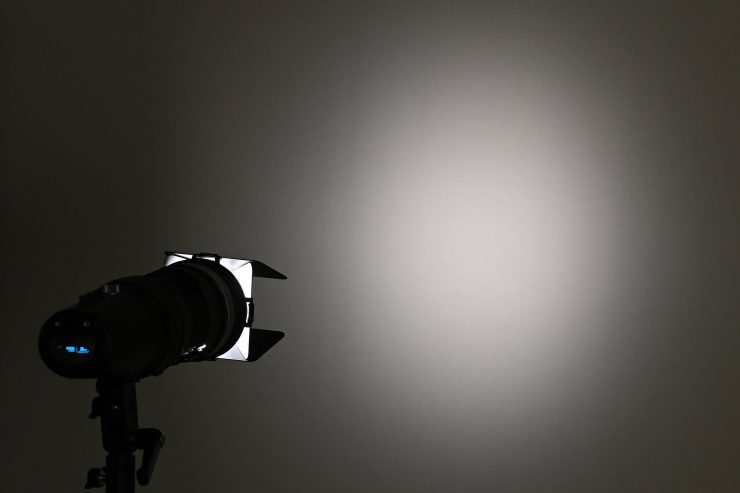
The only way around this was to use the Diffusion Dome and the Fresnel attachment with the barn doors. This got rid of some of the nasty things I was seeing, but the problem with using the Diffusion Dome, is that you can no longer cut the light correctly.
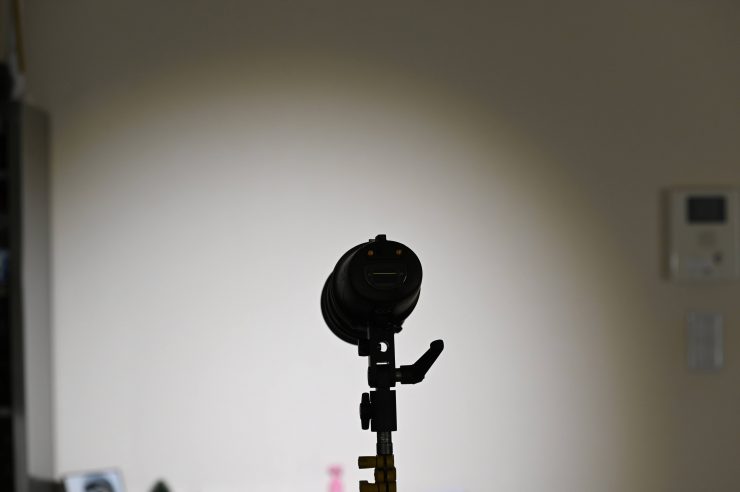
The fall-off is also quite hard when using the Fresnel lens attachment.
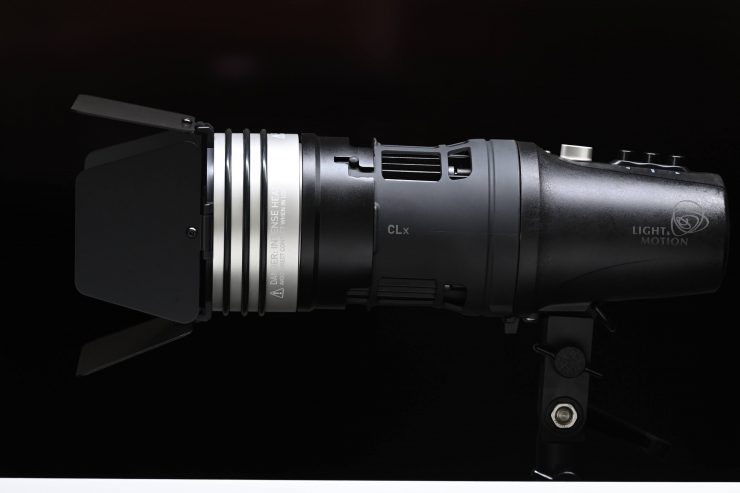
What you need to clearly note is that the optional Fresnel attachment is fixed at 25 degrees and you can’t adjust it. Even when attaching barn doors, you still can’t create a very tight beam angle.

As far as multi–shadows are concerned, the light does a pretty good job. Above you can see the shadow being cast on the wall by the object being lit.
Accessory Mounting Options
The light features a bayonet-style bezel that secures Elinchrom softboxes, and the included Profoto adapter ring provides a mounting solution for other soft light solutions.
The mount also comes with an integrated umbrella holder. It can secure to a C-stand.
Controls & Features
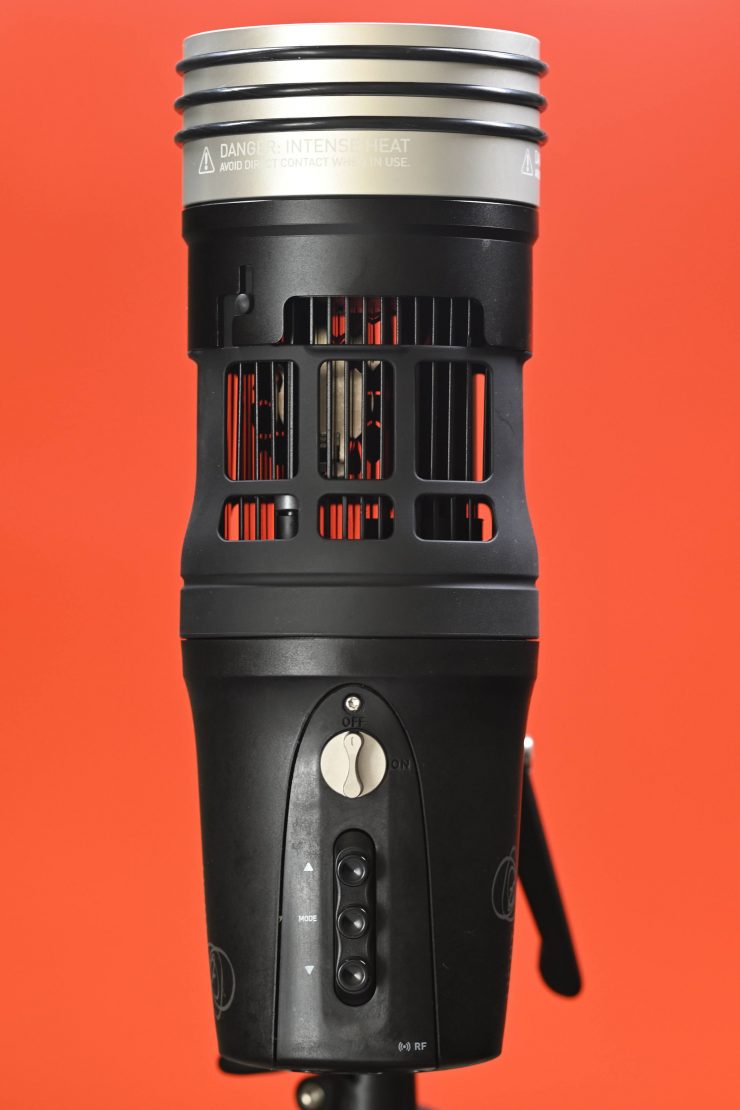
The light has a very basic control layout. There are three buttons that allow you to cycle through the basic functionality.
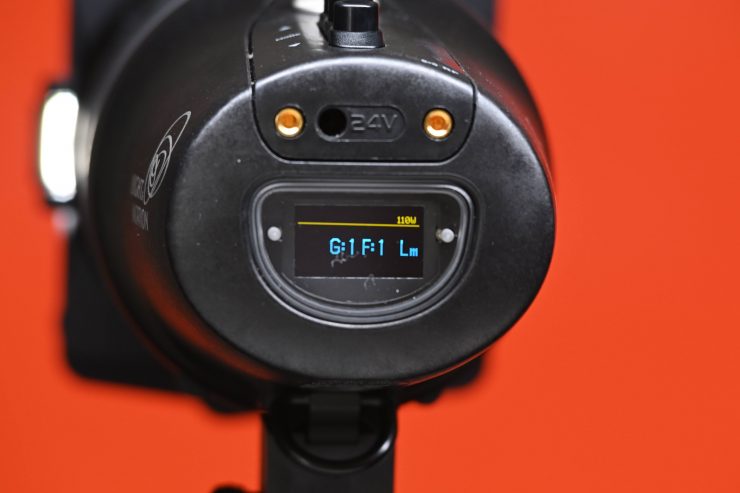
If you long-press the Mode button you can change the channels for Wi-Fi control using the optional remote controller.
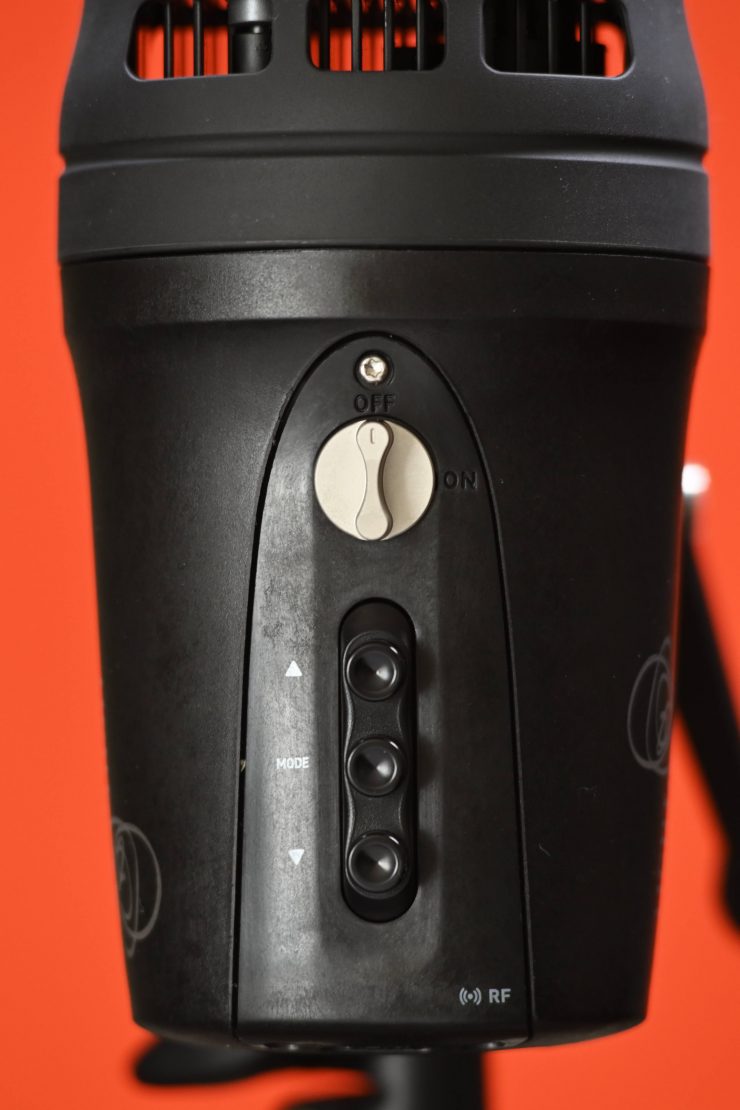
There is also an On/Off switch located just above those three buttons. While we are on the subject of power, the battery won’t charge while the light is in operation.
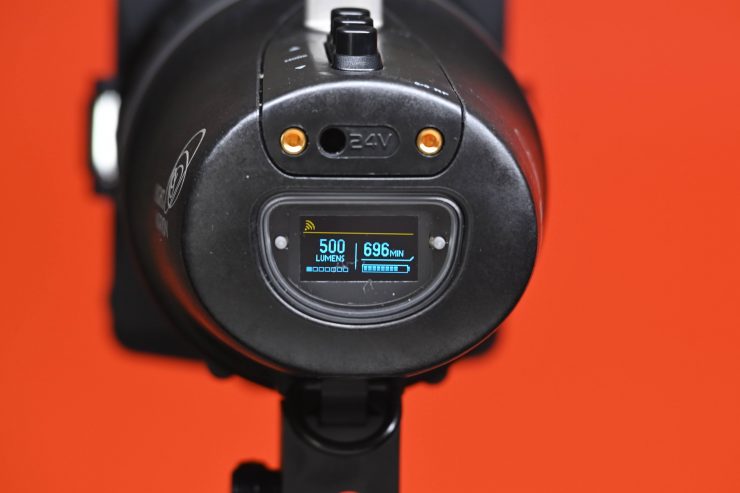
The LED display shows you the lumen output, battery level, a power icon if you have it attached to mains power, and an overheating icon if the light gets too hot.
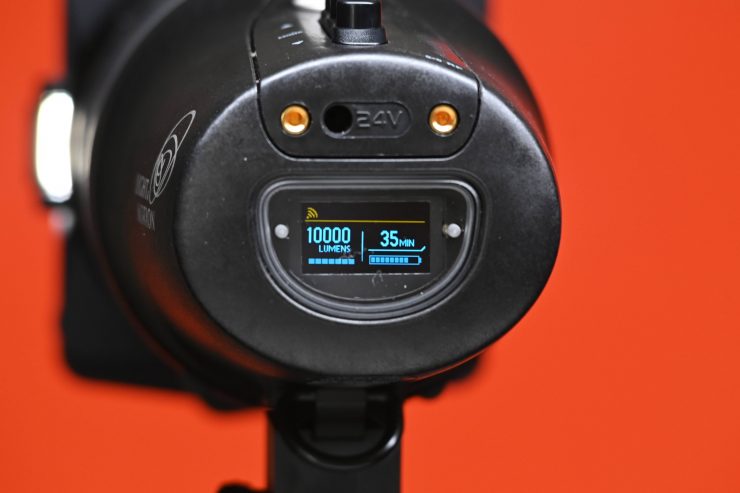
The built-in fan varies from being reasonably quiet, to very loud, depending on what the output is set at. Here is what the fan defaults to in the various output modes:
- 0-4000 lumens: Fan Off
- 4000+-6000 lumens: Fan Low
- 6100- 10000 lumens- Fan High
At 8000 or 10000 lumens, the fan is too loud. You could not use it in any sort of audio critical environment. This severely limits when you can take advantage of that extra output.
What you also need to know is that the Fan will be on low when you are charging the internal battery.
It’s a good thing there is a fan though as the fixture does get very hot in a short period of time.
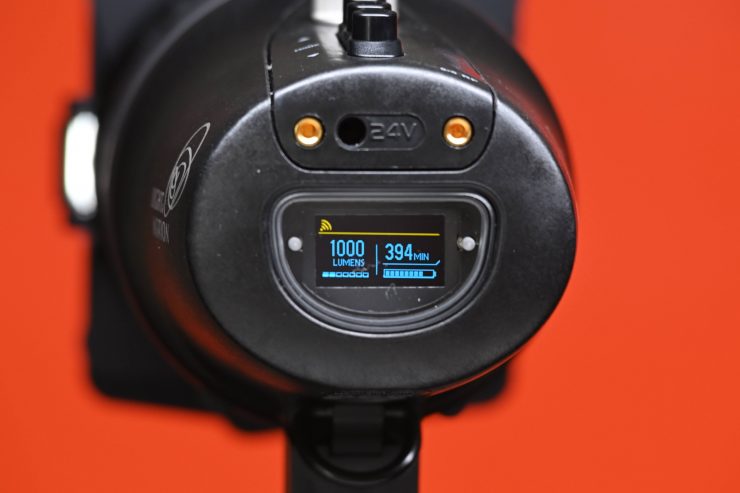
The CLx has all its controls on board, but this does make it harder to make adjustments to the light once it is up high on a light stand. There is an optional remote control you can purchase, but it is $129 USD. I would have liked to have seen some sort of app-based control available.
Power & Powering Options
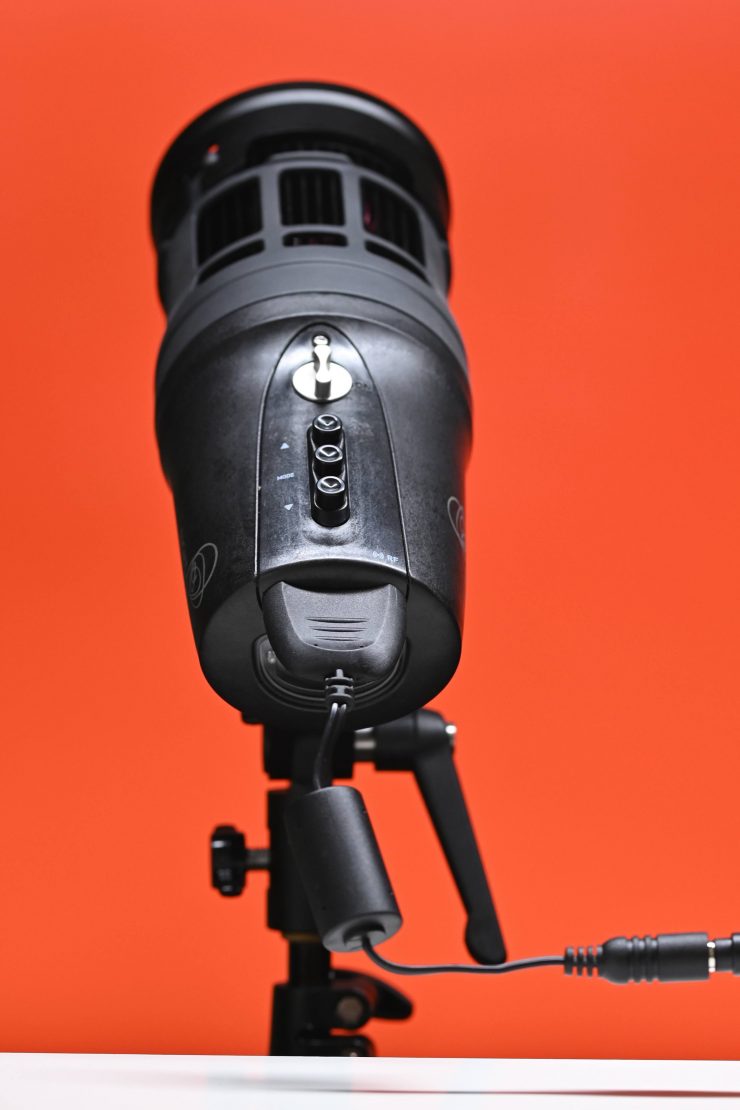
The CLx10 can be powered from its in-built battery or via mains power.
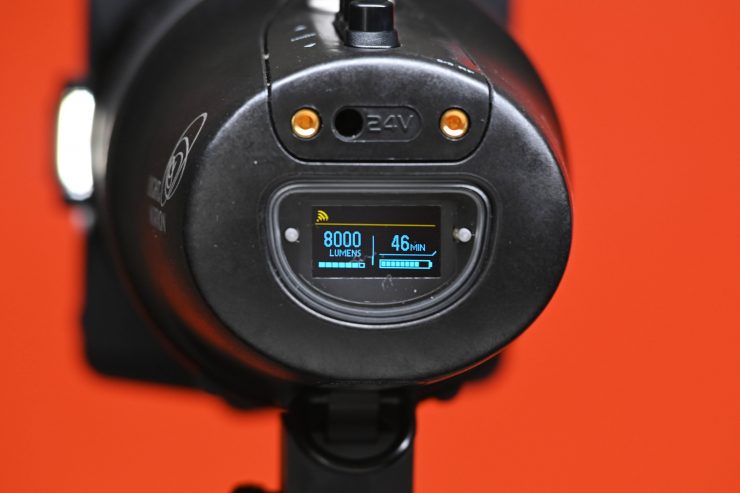
The fixture will run at full output for 55 minutes with its built-in battery (depending on the lumen output). If you don’t need to run it at full output, the light can run for up to 15 hours if you have the lumen setting at its minimum setting of 500 lumens.
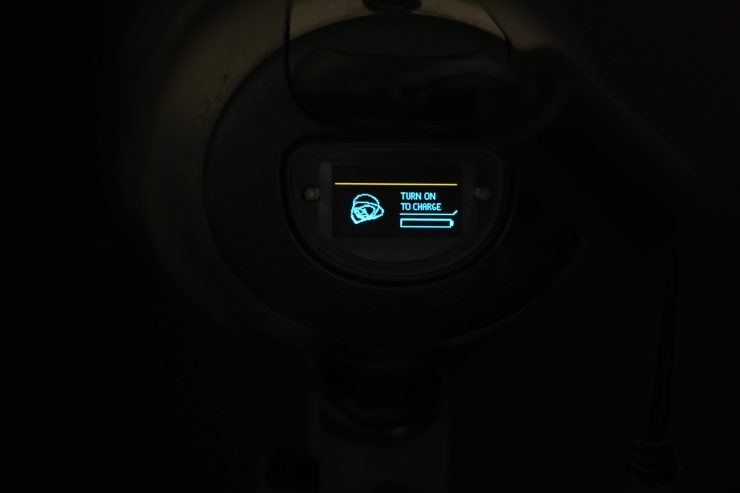
The battery takes approximately 1 hour and 45 minutes to recharge. You need to have the light switched on in order to charge the battery.
The light draws 110W. The internal battery in the light is a 73.5Wh lithium-ion battery.
Photometrics
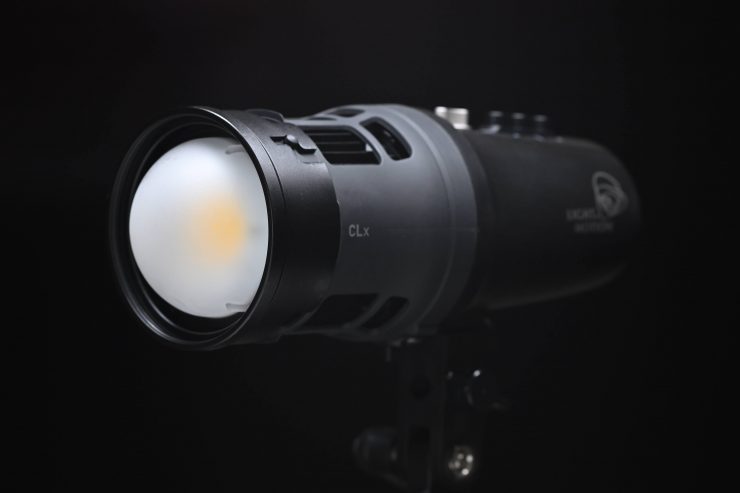
Photometric scores can only tell you so much about a light, but they are still very relevant and with readings such as SSI we can see how well they match other lights.
Output & Kelvin Color Temperature
The output of the CLx10 is going to change depending on what lumen setting you have it at and whether you are using it as an open-face fixture, Fresnel attachment, 50-degree optic, or with diffusion.
So, let’s see how it performed.
10000 lumens Open Face
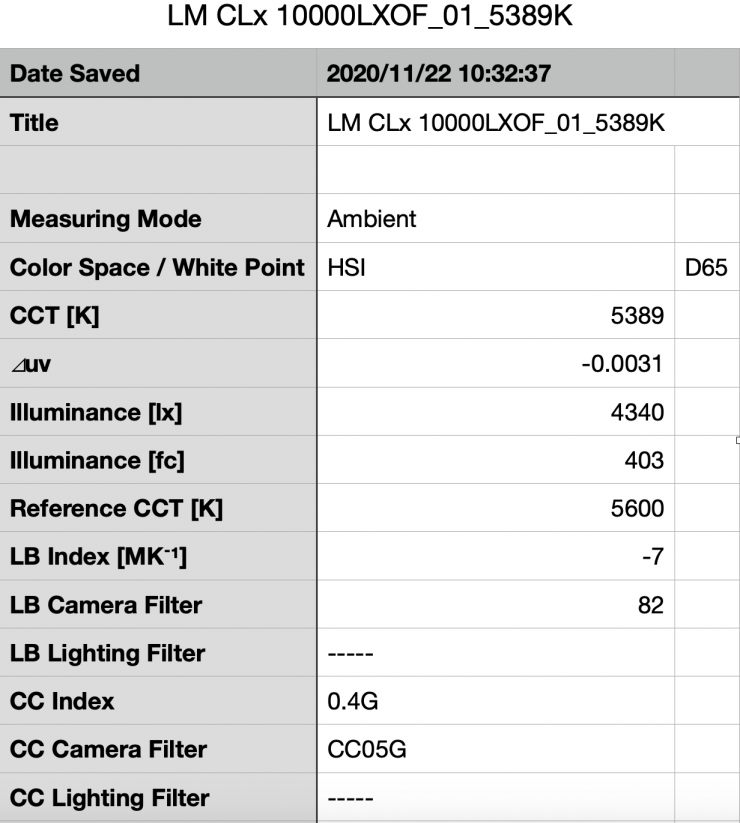
I tested the output of the light when it was set at 10000 lumens with no attachments on it with a Sekonic C-800 at a distance of 1 meter (3.28ft) in a controlled environment. Above you can see that when the light was set at 10000 lumens it produced 4340lx. This is a lot of output from a small-sized fixture with a wide beam angle.
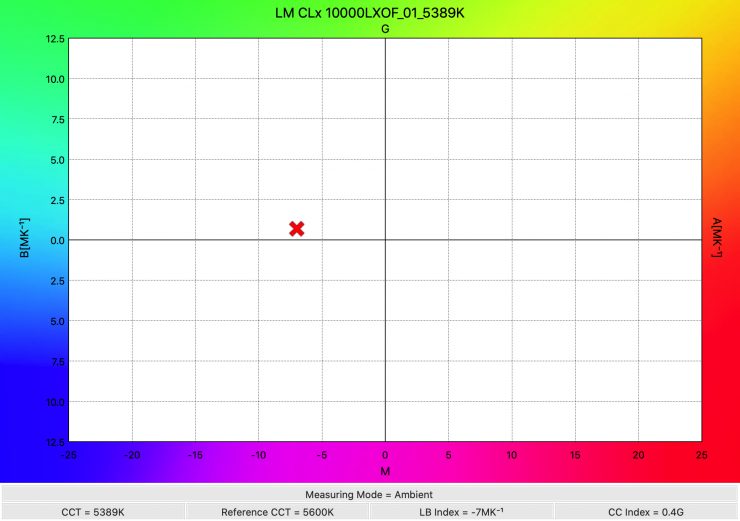
As far as replicating a 5600K source it recorded a Kelvin color temperature of 5389K. This tells me that the light could be slightly more Kelvin color accurate, but in saying that, it is only 111K off being correct. The trouble with this light is you can’t just turn the Kelvin color temperature up a little higher to correct for this, because the fixture is locked at 5600K.
The thing you need to be very aware of is that when you set the light at either 8000 or 10000 lumens of output the fan is automatically activated and it does become quite noisy.
6000 lumens Open Face
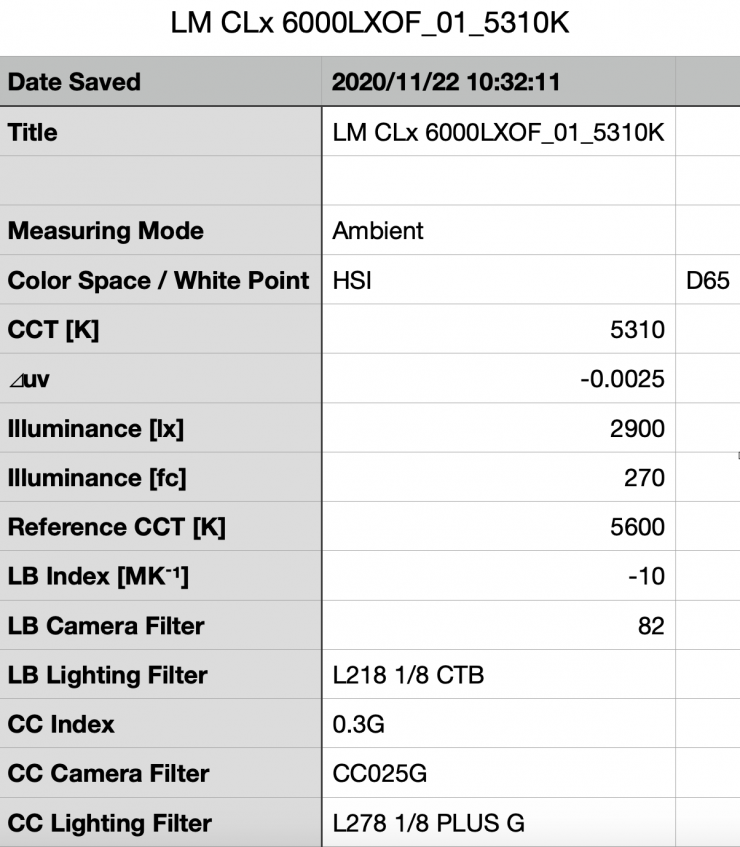
I was also interested to see what the output was when the light was set at 6000 lumens as this the highest output setting you can use without the fan being too loud. Above you can see the results. It recorded 2900lx at a distance of 1 meter (3.28ft). This was 33.1% less output than it had when using it at its 10000 lumens setting. This shows me that the output is not completely linear. If it was, I should have recorded a figure of around 2614lx at the 6000 lumen setting.
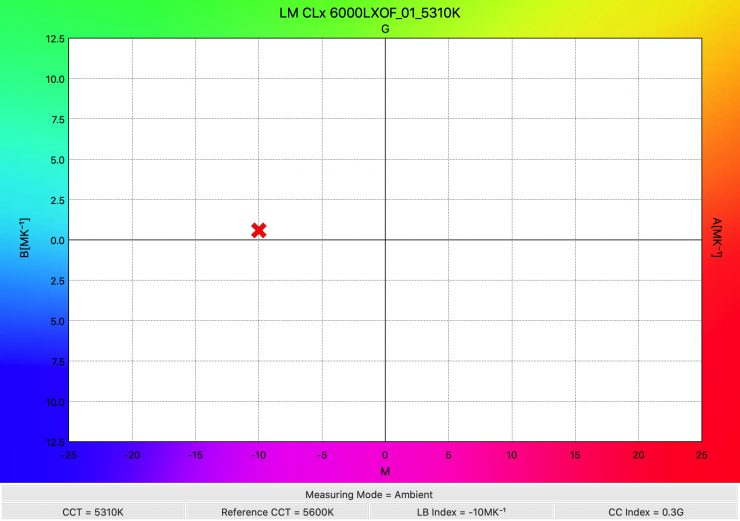
Did the Kelvin color temperature change when using a lower lumen output setting? The light recorded a Kelvin color temperature of 5310K, which was still reasonably close to the reading I got when setting it at 10000 lumens.
Diffusion Dome
The light also comes with a diffusion dome So I wanted to see how much the output was reduced when using it with the fixture in the open face configuration.
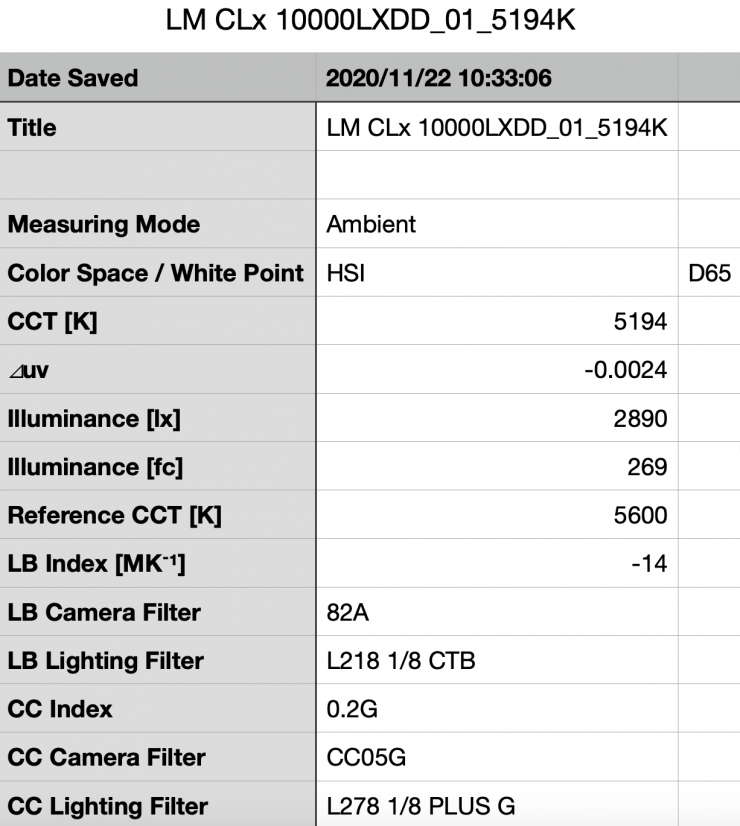
Above you can see that with the diffusion dome the output of the light, when set at 10000 lumens in the open face configuration, recorded a figure of 2890lx. This was 33.4% less output than what the light produced without the diffusion dome. In saying that, 2890lx from a diffused 120-degree lighting source of this size is very impressive.
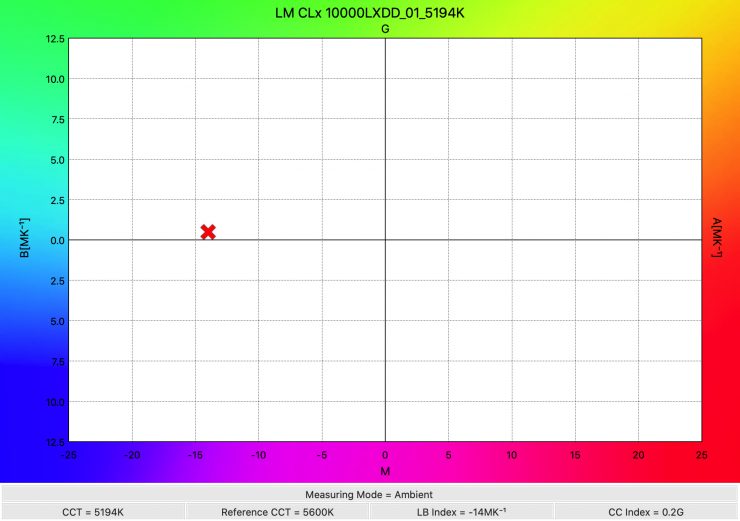
The diffusion dome does alter the Kelvin color temperature of the light. With it on it recorded 5194K which was quite a bit lower than the 5398K it recorded without it being used.
Fresnel Lens
So, let’s now see how much output you get when using the Fresnel lens attachment at both 10000 and 6000 lumens.
10000 lumens Fresnel Lens
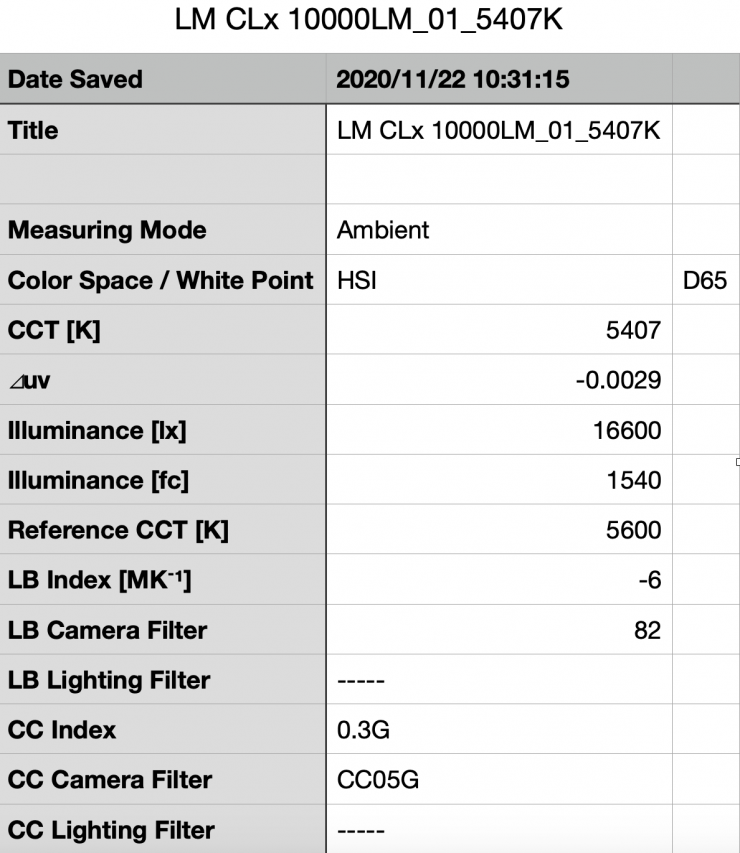
Above you can see the results. It recorded 16600lx at a distance of 1 meter (3.28ft). By adding the Fresnel lens you get a much tighter beam (25-degrees), so it was no real surprise that the output increased dramatically.
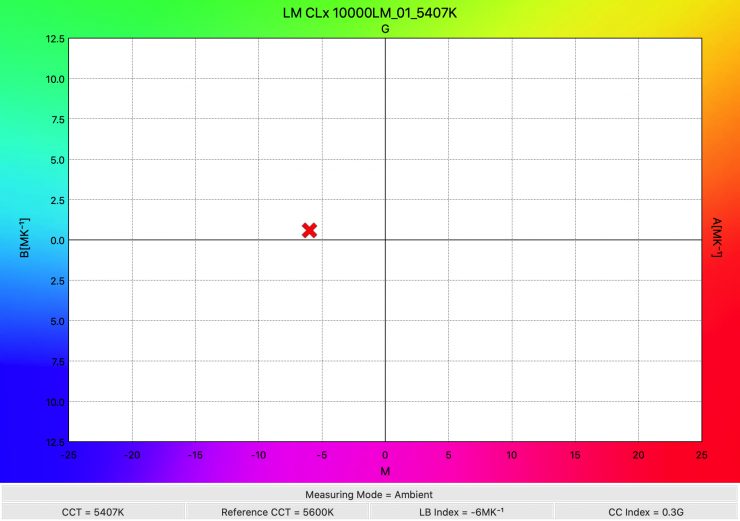
As far as replicating a 5600K source it recorded a Kelvin color temperature of 5407K. It was good to see that the fresnel lens didn’t change the light’s Kelvin color temperature.
6000 lumens Fresnel lens
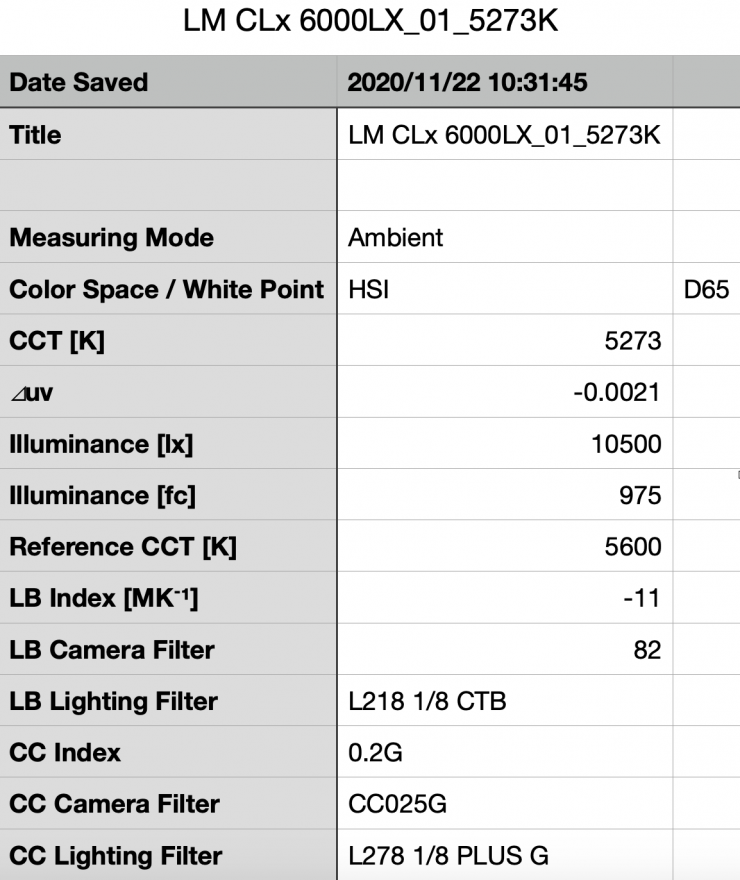
Above you can see that the light recorded an output of 10500lx at a distance of 1 meter (3.28ft) when used at its 6000 lumen setting.
50 Degree Optic
The CLx can also be used with a 50-degree optic. So, let’s see what type of output you get when that is being used.
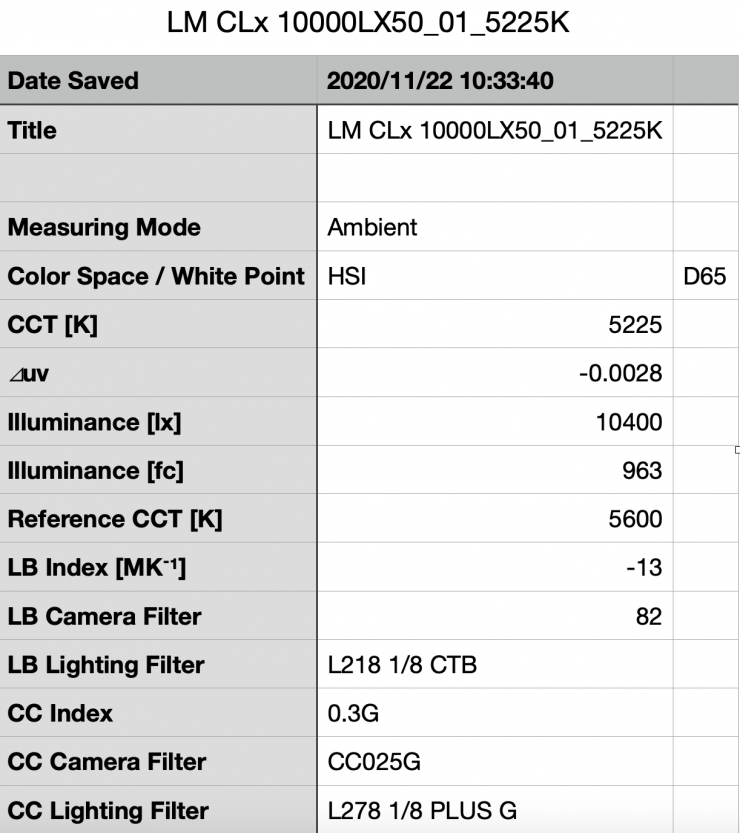
Above you can see that the light recorded an output of 10400lx at a distance of 1 meter (3.28ft) when set at 10000 lumens. The 50-degree optic basically gives you a very similar amount of output to when the Fresnel attachment is being used and you set the light at 6000 lumens. Again, this is a tremendous amount of output from a small fixture. The only problem when using the 50-degree optic is that you can’t run the Dome Diffuser at the same time.
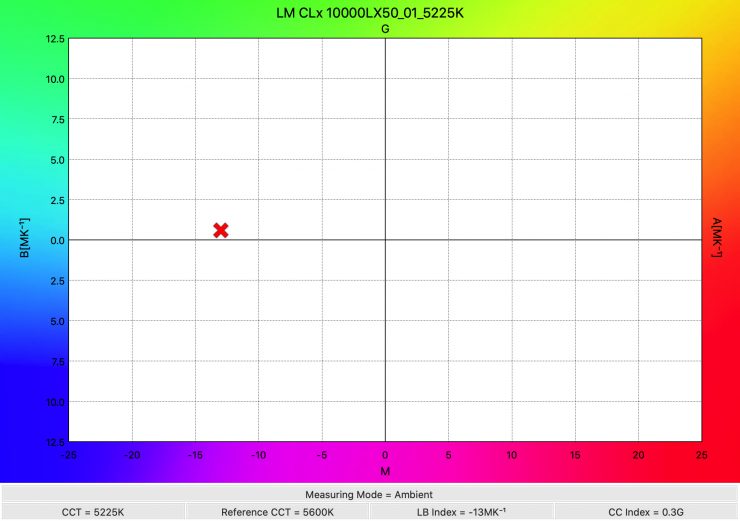
As far as replicating a 5600K source it recorded a Kelvin color temperature of 5225K. This means that the 50-degree optic is changing the Kelvin color temperature of the light slightly. This is something you need to be aware of.
Summary of Output & Kelvin Color Temperatures
| OUTPUT | KELVIN | |
| 6000 lumens Open Face | 2900lx | 5310K |
| 10000 lumens Open Face | 4340lx | 5398K |
| 10000 lumens Open Face (Diffusion Dome) | 2890lx | 5194K |
| 6000 lumens Fresnel | 10500lx | 5273K |
| 10000 lumens Fresnel | 16600lx | 5407K |
| 10000 lumens 50 Degree Optic | 10400lx | 5225K |
Color rendering
So now we have seen how much output the light has, but how does it perform when it comes to rendering colors accurately? Again, I tested the light with a Sekonic C-800 at a distance of 1m (3.28ft) in a controlled environment to see how the light performed.
10000 lumens Open face
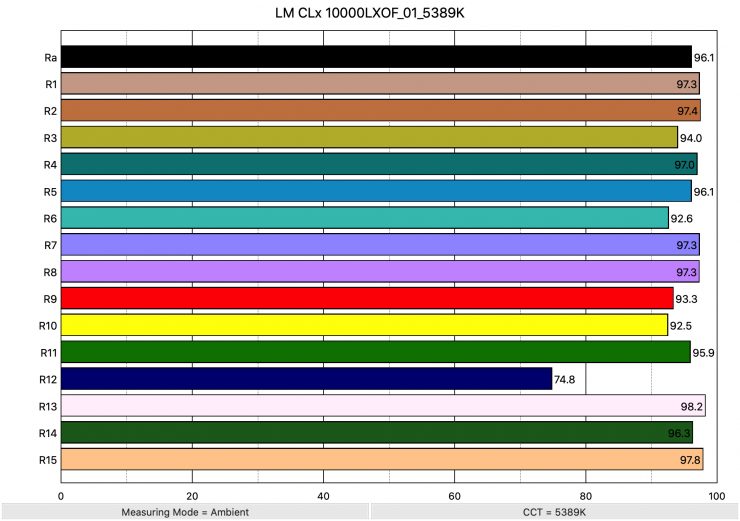
Above you can see that the light recorded an average CRI (R1-R8) of 96.1 and an extended CRI (R1-R15) of 94.52. For replicating skin tones accurately it recorded 93.3 for R9 (red), 98.2 for R13 (closest to caucasian skin tones), and 97.8 for R15 (closest to Asian skin tones). These figures were very good.
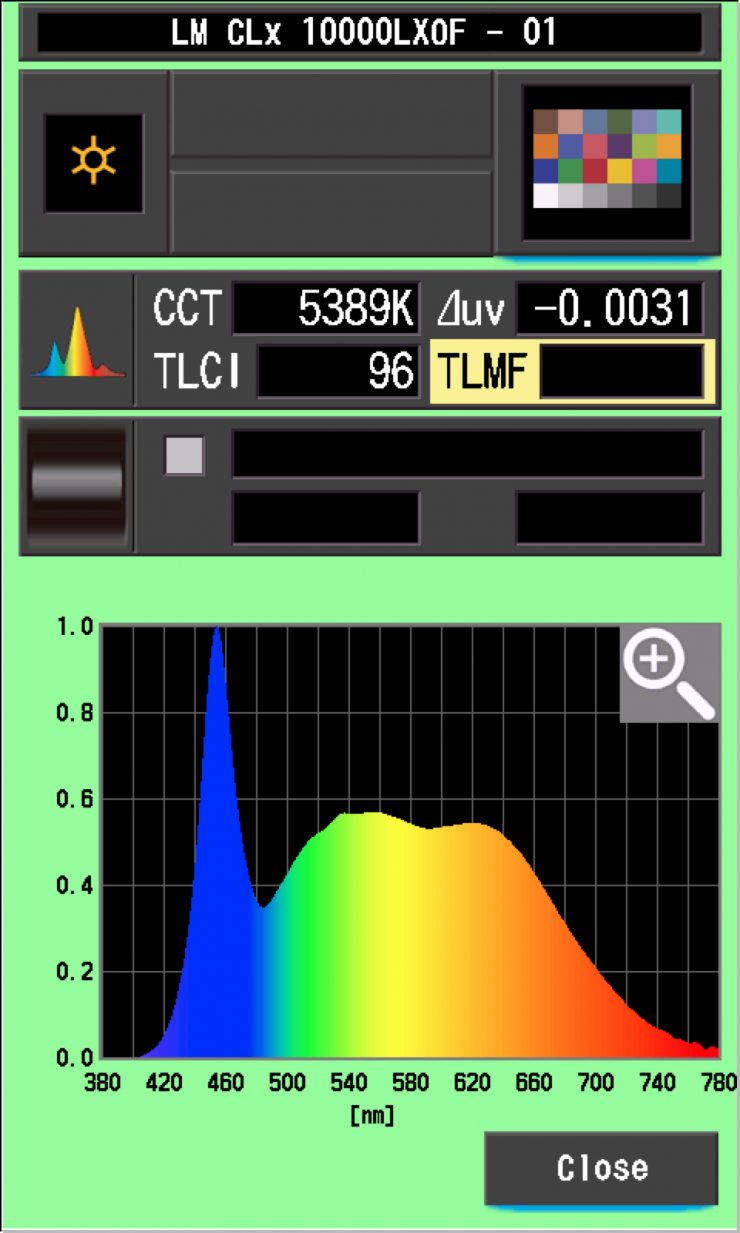
The light also recorded a TLCI score of 96.
6000 lumens Open face
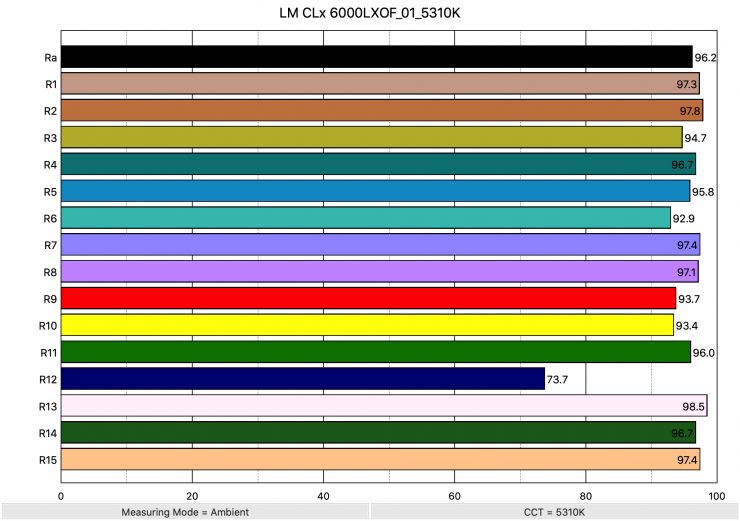
I was interested to see if the color accuracy changed when the output of the light was lowered, so I also tested it at 6000 lumens.
Above you can see that the light recorded an average CRI (R1-R8) of 96.2 and an extended CRI (R1-R15) of 94.6. For replicating skin tones accurately it recorded 93.7 for R9 (red), 98.5 for R13 (closest to caucasian skin tones), and 97.4 for R15 (closest to Asian skin tones). These figures were almost identical to when it was set at 10000 lumens.
CC Index & ⊿uv
The CC Index displays the CC correction value and whether any magenta or green need to be added or subtracted. 1 CC corresponds to 035 Kodak CC values or 1/8 Rosco filter values. Any reading less than +1.00 or -1.00 and you’re probably not going to need to make any kind of adjustment. The ⊿uv is the value to show how much this light is away from being an ideal light source (black body radiation = incandescent lamp). As with the CC Index you want this number to theoretically be zero. Kelvin is not a linear value, so we need to convert from Kelvin to MK-1 to compare the values of color temperature. To calculate from Kelvin to Mired is MK-1= 1*1000000/Kelvin. While this may sound confusing, it is the only way of measuring if the Kelvin shift is significant enough to warrant having to use a filter for correction. Below are the results for the fixture
Kelvin Vs MK-1
| Kelvin | Difference in K | MK-1 | Difference in MK-1 | |
| SET VALUE | 5600K | 0 | 178.57 | 0 |
| ACTUAL READING | 5398K | 202 | 185.25 | 6.68 MK-1 |
These figures might look confusing, but what it tells me is that the light is reasonably Kelvin color accurate. Any MK-1 score that is under -9/9 means you wouldn’t have to use any color correction gels.
What about if I was using the light with the dome diffuser?
| Kelvin | Difference in K | MK-1 | Difference in MK-1 | |
| SET VALUE | 5600K | 0 | 178.57 | 0 |
| ACTUAL READING | 5194K | 306 | 192.52 | 13.95 MK-1 |
What this tells me is that the light would need to have some sort of correction gel used to replicate a 5600K source. A MK-1 score that is over -9/9 means you would have to use a color correction gel.
CC INDEX & ⊿uv
| CC INDEX | ⊿uv | |
| 10000 lumens Open Face | 0.4G | -0.0031 |
| 6000 lumens Open Face | 0.3G | -0.0025 |
| 10000 lumens Fresnel | 0.3G | -0.0029 |
| 6000 lumens Fresnel | 0.2G | -0.0021 |
| 10000 lumens 50 degree Optic | 0.3G | -0.0028 |
| 10000 lumens Open Face Dome Diffuser | 0.2G | -0.0024 |
Above you can see CC Index and ⊿uv scores for the light when it was used in various configurations. It is nice to see that the light is consistent in all configurations.
SSI
SSI (Spectral Similarity Index) was developed by the Sci-Tech Council of the Academy. SSI gives me the ability to set any light as a standard, or use predefined standards (such as CIE D55), and then give other lights an SSI score based upon how well they will match standards such as CIE D55 measure spectral response and compare it directly against an ideal light source.
SSI is a much better way to judge an LED light than CRI or TLCI.
SSI is useful to see how well different lights will play together. As the Sekonic C-800 Spectromaster can measure SSI, I decided to test out the Light & Motion to see how it performed.
10000 lumens Open Face
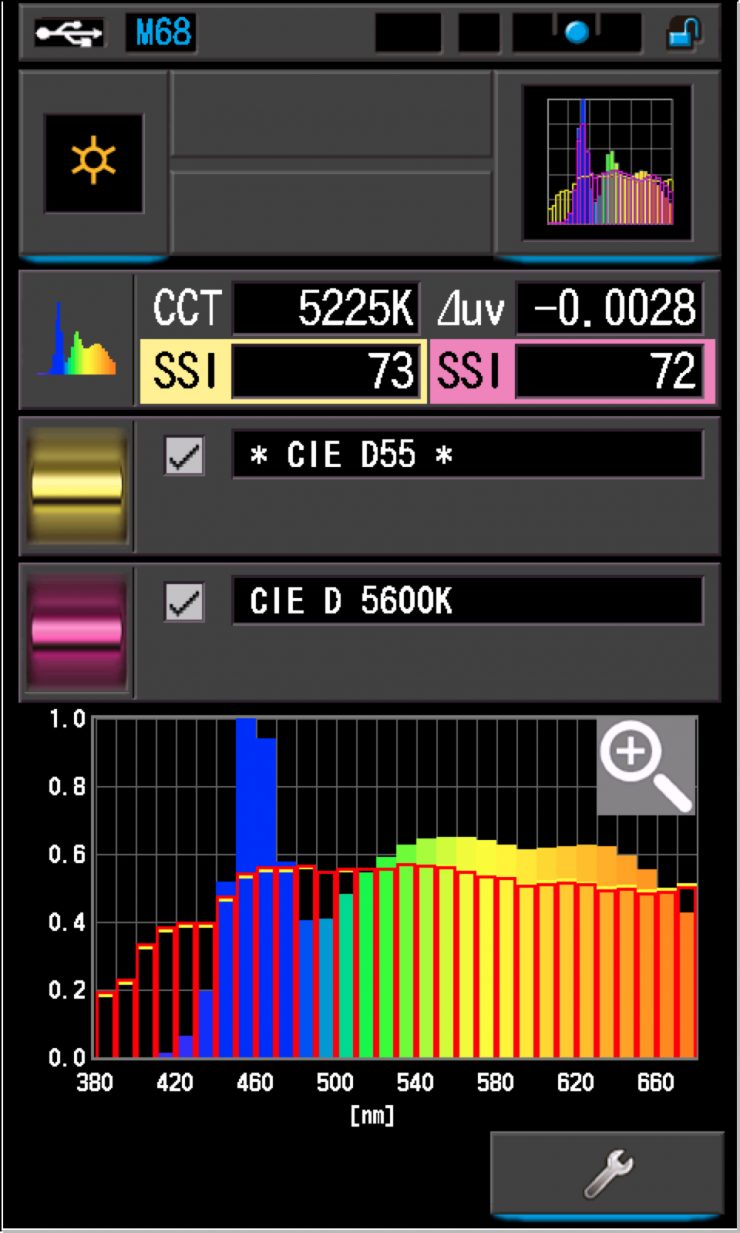
Above are the scores for the light when used at 10000 lumens. The scores show that the light does a good job of accurately replicating a CIE D55 source. A score in the low to mid-70s is very typical for a 5600K LED light.
The main reason we want to record SSI scores is so we can see how well they match with other lights. As an example, let’s see how well the Light & Motion matches the CAME-TV Boltzen 150. Below you can see the results.
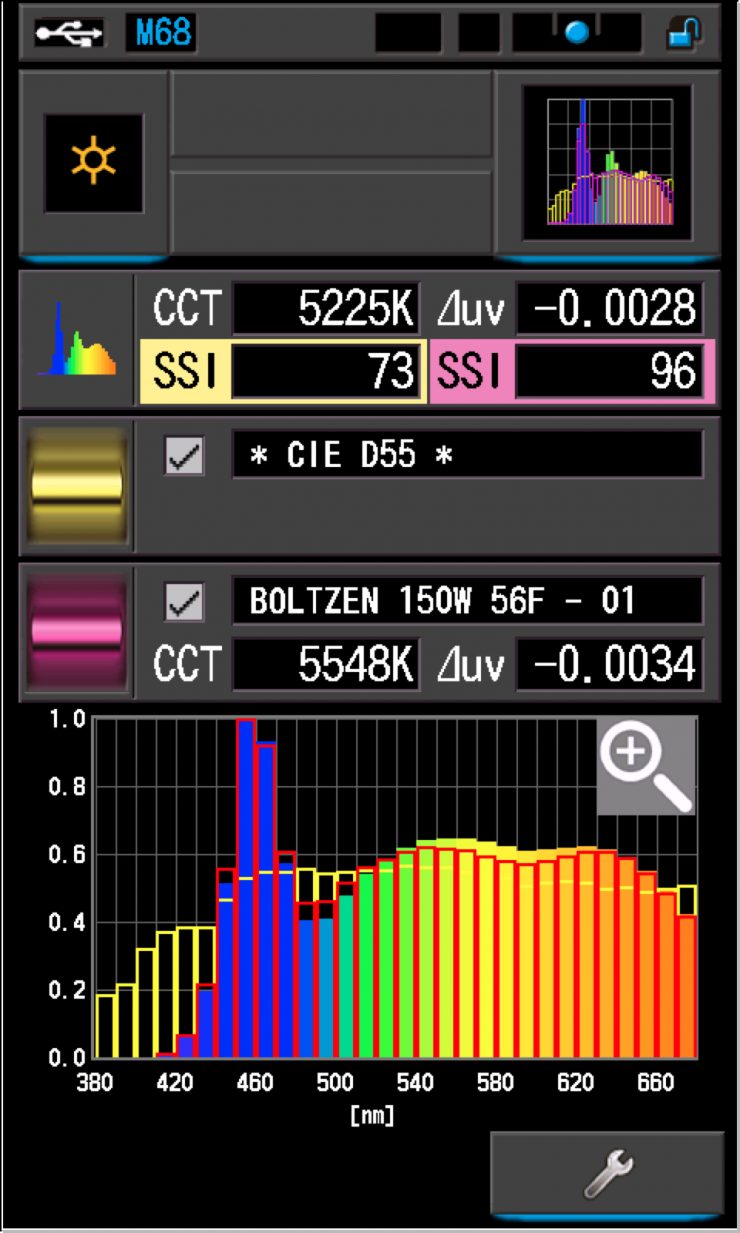
As you can see the Light & Motion CLx and the CAME-TV are a very close match when used at 5600K. A score of 96 indicated that the lights could be used together with almost no discernible difference.
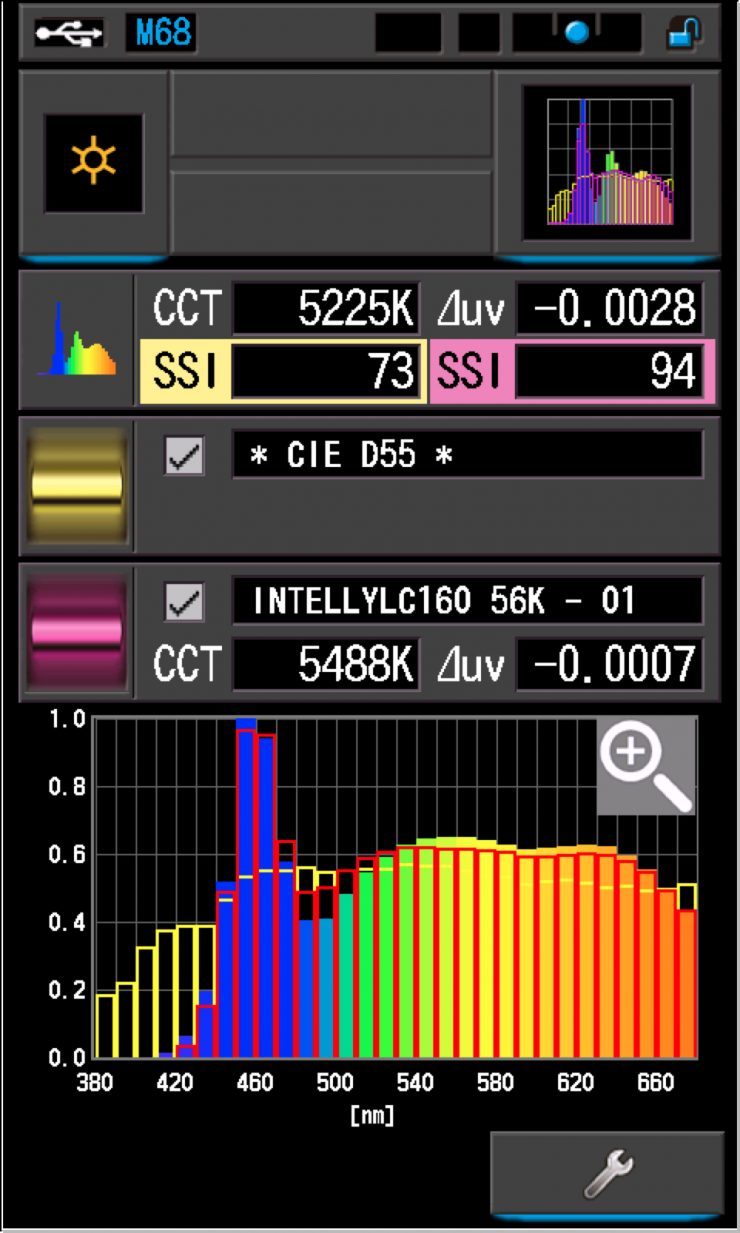
So again, as an example, let us see how well the CLx matches the Intellytech Litecloth LC-160 v2 2×2” Folding LED Mat Light. Above you can see that while not a perfect match they will still work well together. Any score in the 90s means that your lights have a pretty good chance of matching reasonably well.
Being able to measure SSI in advance and compare different lights you may be using together is a great way of finding out what lights will work together and what adjustments need to be made.
Spectral Distribution
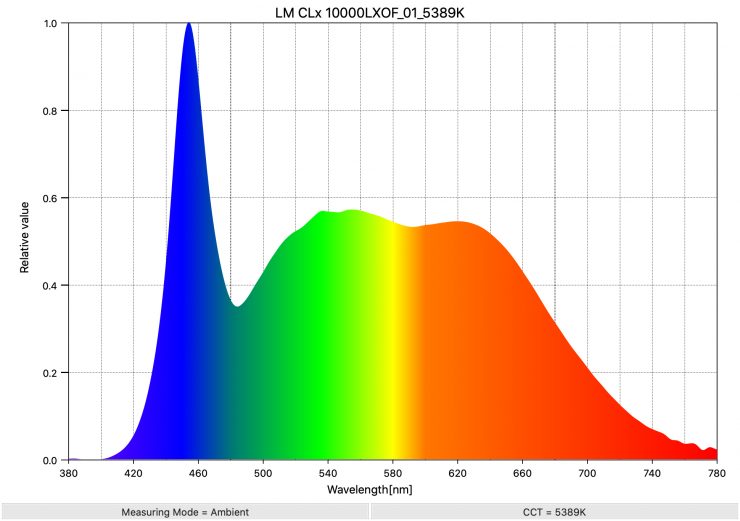
Above you can see the spectral distribution of the CLx10. The spectral distribution is reasonably good and there aren’t any large spikes where there shouldn’t be.
So how does the light actually perform?
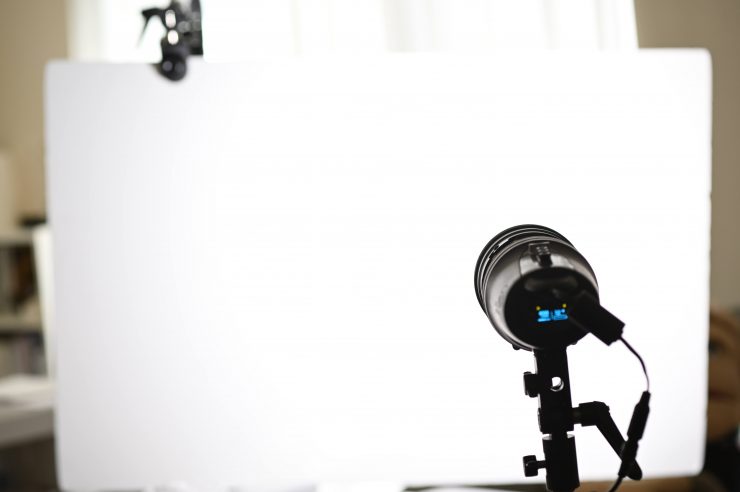
It’s important to remember that these lights by their very design are hard light sources and they will produce strong shadows. However, they can be used as a soft light by adding diffusion or through the use of light modifiers. You could also use the light as an indirect source by bouncing it off a wall or ceiling, etc.
I found that the light actually worked well if you directed it into a bounce board or umbrella etc. The light has enough output, even if you are not running it at 8000 or 10000 lumens to be able to do this.

Above you can see a few examples of the light being used at various output strengths where it is being bounced into a poly board. I have positioned the poly board at various angles so you can see the difference.


CLx On 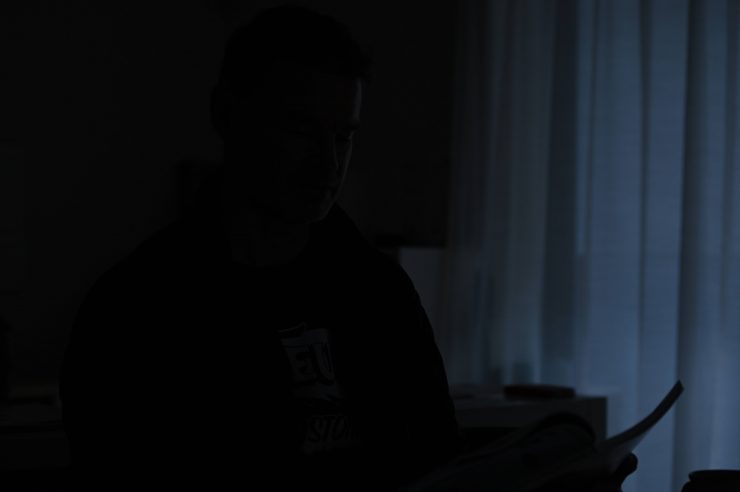
light turned off
As far as output is concerned, this light has a lot. Above you can see two images where the only light source is the CLx. It is being bounced directly into the ceiling, and it is 260cm (8.5′) away from where I am sitting. Even at this distance, I was able to get correct exposure by setting the camera to 800 ISO, f/5.6, 1/50th shutter.

Even when I added the Diffusion Dome, I could still get correct exposure at the same distance by setting the camera to 800 ISO, F/4, 1/50th shutter.
It is nice that you can run this light off the in-built flight safe battery. That, along with its reasonably compact size, and high output makes it a good light to travel with. The biggest downside is that the light will only run for just under an hour at 100% output from the in-built battery. It would have been nice to have seen some sort of D-tap power cable so you could run the fixture from a camera battery.
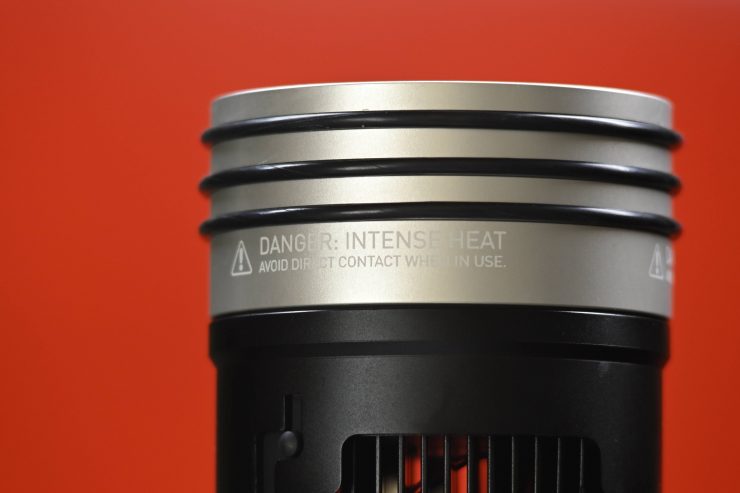
The two biggest problems for me with this light are heat and fan noise. The light gets ridiculously hot and this becomes a problem if you want to add or remove accessories. It also means you have to be careful when packing it away as you need to wait till it cools down.
The fan noise at 8000 or 10000 lumens is very loud and this makes it unusable in audio-critical situations such as interviews etc. I found that I couldn’t use it at lumen outputs of above 6000 for interviews. It is great to have lots of output, but if that output becomes unusable because the light gets so hot and the fan has to run, then what is the point of having that output in the first place?
High powered, compact fixtures like the CLx10 can be a good solution if you can only take one light with you. Because it is a hard lighting source you can use it to bounce off surfaces, spot it up to light objects from a distance, or diffuse it to create a softer lighting source. In saying that, small lights like this are never going to be a substitute for larger sources when creating soft light.
While it is not going to be suitable for every lighting application, you can still get it to do a lot if you need a versatile fixture in a compact form factor.
Price
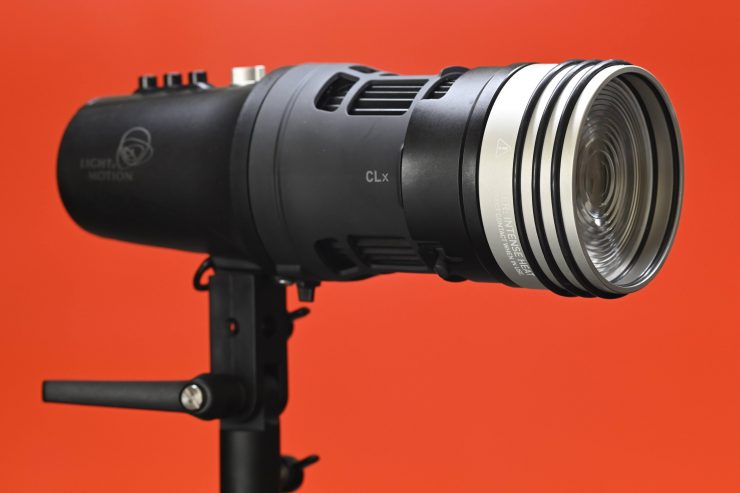
The Light & Motion CLx10 is not a particularly affordable LED fixture. It retails for $1299 USD. By the time you include accessories, the price starts to really add up.
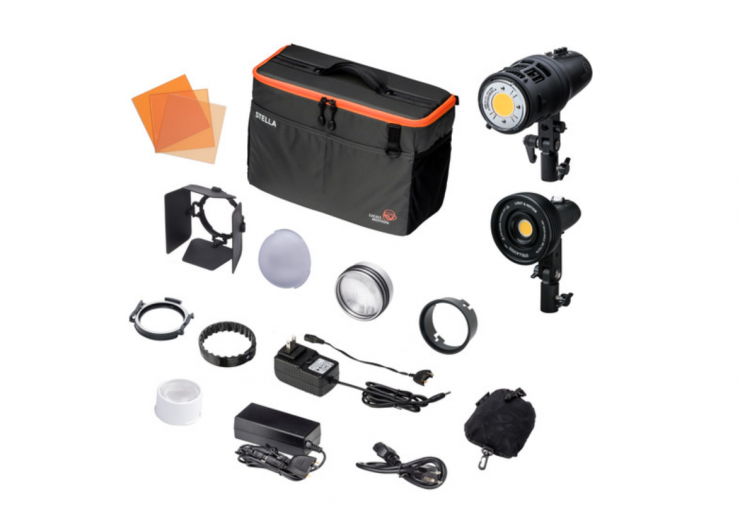
Light & Motion also sells a range of CLx10 kits:
- Light & Motion CLx10 LED Photo Kit $1699.99 USD
- Light & Motion Stella Pro 2-Light Storyteller Kit $3,199.99 USD
- Light & Motion CLx10 and Stella 2000 LED Portrait Plus Kit $1,598.99 USD
The Light & Motion CLx10 and Stella 2000 LED Portrait Plus Kit is currently on sale for $1,598.99 USD. In this kit you get the following:
- Light & Motion CLx10 LED Light
- Light & Motion Profoto Adapter for Stella Pro 5000/5000 RF and Pro 8000
- Light & Motion YS Mount Base with Umbrella Holder for Stella 1000/2000 Lights
- Light & Motion Flat Port DM for Stella CLx
- Light & Motion C-Stand Mount for Stella LED Lights
- Light & Motion High Leverage Handle for Stella YS Mount
- Light & Motion Power Adapter for Stella Pro 5000 & Sola 8000 (24V, US/JP)
- Limited 2-Year Warranty on Light
- Limited 90-Day Warranty on Battery
- Light & Motion Stella 2000 5600K LED Light
- Light & Motion Power Adapter for Stella 1000 and 2000 (12V, US/UK/EU/AUS)
- Light & Motion YS Mount for Stella Pro Series LED Lights
- Light & Motion C-Stand Mount for Stella LED Lights
- Light & Motion Dome Diffuser DM
- Light & Motion 4-Way Barndoors for Stella 2000 and 5000 LED Light Heads
- Light & Motion 50-Degree Optic DM
- Light & Motion Fresnel Lens for Stella 2000 and 5000 LED Lights
- Light & Motion CTO Filter Set for Stella 2000
- Light & Motion Press-On Modifier Interface for CLx LED Light
- Light & Motion Speedring Gel Holder
- Large CL Action Kit Soft Case
In my honest opinion, this kit offers a lot better value for money than just buying a CLx by itself.
Competition
Despite the CLx10 being quite a niche light, there are actually quite a few other fixtures you could compare it to.
Other lights that are similar include:
- Genaray PortaBright Daylight LED Battery Powered Monolight $199 USD
- Nanlite Forza 60 LED Monolight $289 USD
- Godox SL-100 LED Video Light (Daylight-Balanced) $189 USD
- Dracast Boltray LED600 Plus Daylight LED Light $199 USD
- Aputure Light Storm LS C120D II LED Light Kit with V-Mount Battery Plate $745 USD
- Kinotehnik Practilite 602 LED Fresnel $899 USD
Please note that all of these lights have different features and functionality.
Optional Extras
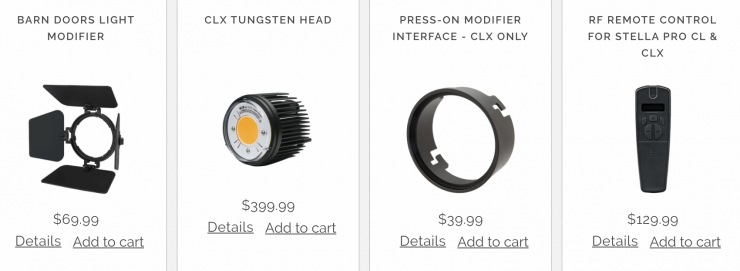
Light & Motion offers a range of accessories for the CLx10, including barn doors, a remote controller, and a Tungsten light head.
Conclusion
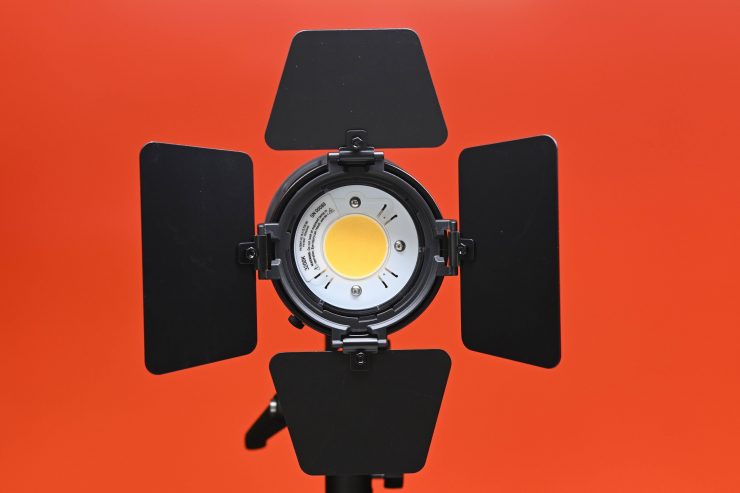
The Light & Motion CLx10 is a reasonably impressive fixture, but it is expensive. While I liked the light I kept asking myself why would I buy this over some of the other options that are out there. The biggest reason would have to be output. This light packs a serious punch and you can use it to light up small-sized rooms by bouncing the light to ceilings or walls. The color rendering scores are good.
Versatility and high output are undoubtedly this light’s best strengths, but at $1299 USD, it is going to be hard to convince potential buyers that is this is a better option than some more affordable lights.
I personally found that the heat it generates and the fan noise at higher lumen outputs were a big problem. I also didn’t find the Fresnel attachment to be very useful as it doesn’t cut particularly well.
The Light & Motion CLx is a good light, but it does come with a lot of caveats. As long as you are aware of these caveats and can work around them, then the CLx makes for a compelling, although expensive, compact lighting solution.
Like what we do and want to support Newsshooter? Consider becoming a Patreon supporter and help us to continue being the best source of news and reviews for professional tools for the independent filmmaker.

